SPARTA User Guide
Introduction to SPARTA
What is SPARTA?
Space systems provide critical capabilities that power global industries and enable several facets of everyday life. During a conflict, adversaries may seek to deceive, deny, disrupt, degrade, or destroy those capabilities. Cyberattacks are a complex but effective and increasingly prevalent attack vector in the space domain. To counter cyber threats, cybersecurity and space operations are becoming inextricably linked. Though spacecraft have historically been considered relatively safe from cyber threats, they are squarely in the crosshairs within the modern threat landscape.
Cybersecurity matrices have become an industry-standard approach for providing a knowledge base of adversary behaviors, helping visualize and categorize threats, and serving as a taxonomy for adversarial actions across the attack lifecycle for a number of industry sectors. However, there has traditionally been no framework dedicated to address cyber threats to the spacecraft or space vehicles that are critical enablers of many of those sectors and important facets of daily life.
To fill this gap, The Aerospace Corporation (Aerospace) developed the Space Attack Research and Tactic Analysis (SPARTA) cybersecurity framework, the first cybersecurity threat identification and response framework purposefully designed to help spacecraft developers, owners, and operators outpace space-cyber threats.
Cybersecurity matrices have become an industry standard approach for providing a knowledge base of adversary behaviors and serve as a taxonomy for adversarial actions across the attack lifecycle. The Aerospace Corporation created the Space Attack Research and Tactic Analysis (SPARTA) matrix to address the information and communication barriers that hinder the identification and sharing of space-cyber-Tactic, Techniques, and Procedures (TTP). SPARTA attempts to aggregate unclassified research from academia, Federally Funded Research and Development Centers, and space cyber professionals into a single pane of glass to better educate the space community on TTPs while also identifying countermeasures within SPARTA.
Who should use SPARTA?
Acquisition/Procurement Professionals looking to bolster RFPs, contracts, and statements of work with explicit security-focused requirements for acquired spacecraft systems and components.
Space System Developers that need to understand threats and the countermeasures necessary to defend against them, enabling the engineering of protections throughout the development and operational lifecycle of their mission.
Defensive Cyber Operators tasked with building monitoring solutions and measuring how effective systems/operators are at detecting malicious activity within their specific space system.
Threat Intelligence Analysts and Researchers looking for an industry standard taxonomy for tagging malicious events/incidents to improve reporting, information sharing, and historical tracking of events.
Cybersecurity Assessors tasked with evaluating and testing mission systems can utilize SPARTA to develop attack chains against their systems.
Risk Managers & Compliance Officers responsible for identifying, implementing, or evaluating a security control package for a spacecraft.
Educators/Researchers looking to expand the footprint of space-cyber knowledge to a wider audience and raise the bar on what is considered common knowledge across the industry.
SPARTA Matrix Anatomy
Aerospace recognized that a dedicated security framework would help space developers and network defenders understand and address unique space-cyber threats. Introduced in 2022, SPARTA aggregates unclassified information and research from academia, space-cyber professionals, and federally funded research and development centers into a single resource to better educate the space community about how spacecraft may be compromised via cyber means, while also identifying associated countermeasures.
SPARTA, like preceding security matrices that inspired it, documents possible attack chains and visually organizes cyber tactics, techniques and sub-techniques (commonly referred to as “TTPs” that may compromise spacecraft. SPARTA catalogs TTPs that are either theoretically possible or have been proven in laboratories, on-orbit exercises, and hacking workshops, as well as countermeasures spacecraft can implement to outpace cyber threats.
- Tactics represent the threat actor’s tactical goal and the reason(s) they are performing a technique. For example, a threat actor may want to achieve initial access on a spacecraft via cyber means. Other tactics include reconnaissance, resource development, execution, defense evasion, exfiltration, lateral movement, and impact.
- Techniques represent “how” a threat actor achieves a tactical goal by performing a threat action. For example, a threat actor may exploit trusted relationships to achieve initial access. SPARTA maps a range of techniques that threat actors can use to execute tactics.
- Sub-techniques represent a variation or more specific instance of the threat actor’s behavior used to achieve a goal. Sub-techniques typically describe behavior at lower levels than a technique and are considered children of the parent technique. For example, a threat actor may compromise mission collaborators (academia, international, etc.) to achieve their initial access.
Navigating the SPARTA home page
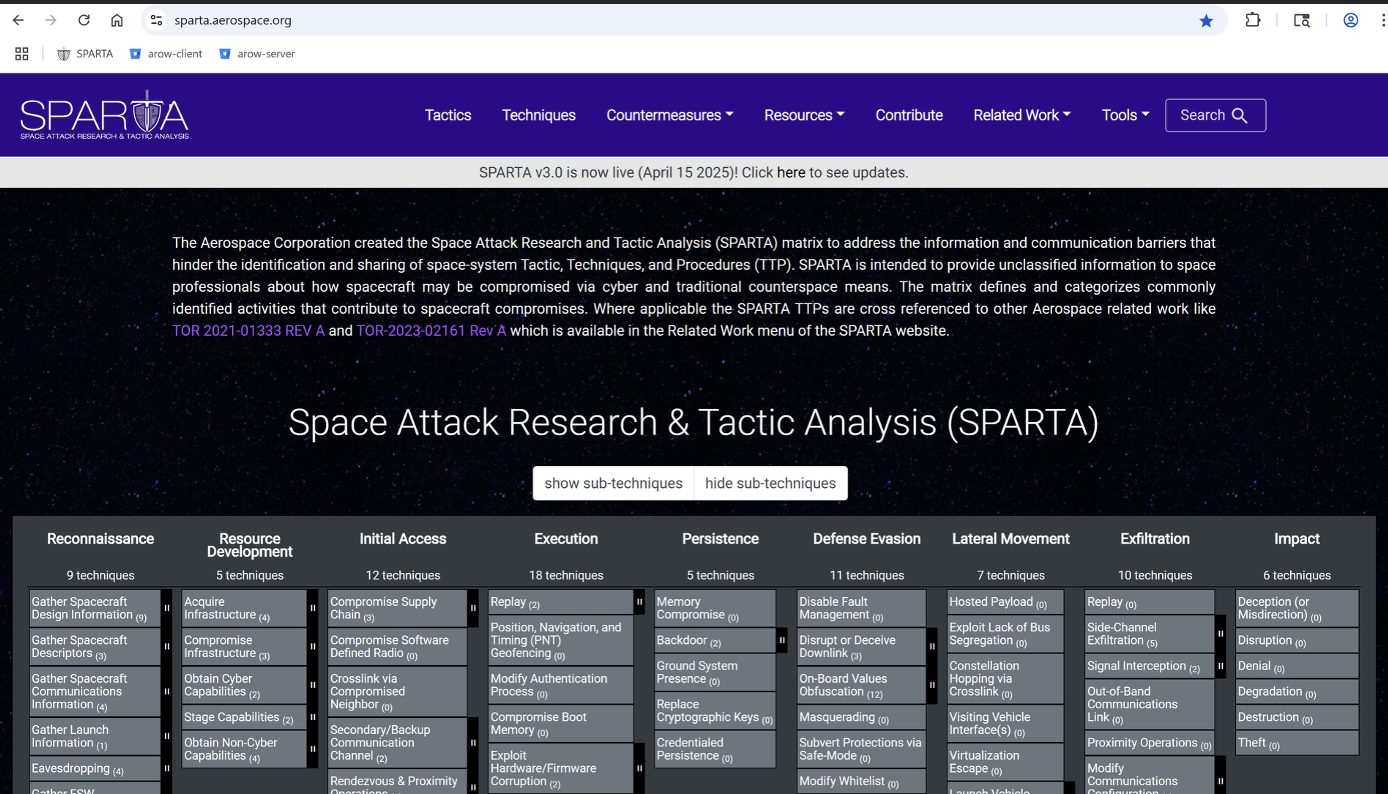
At the top of the SPARTA website there exists labels to guide the user experience.

And on the main landing page the SPARTA Framework exists, where all known Tactics, Techniques and Sub Techniques can be seen:
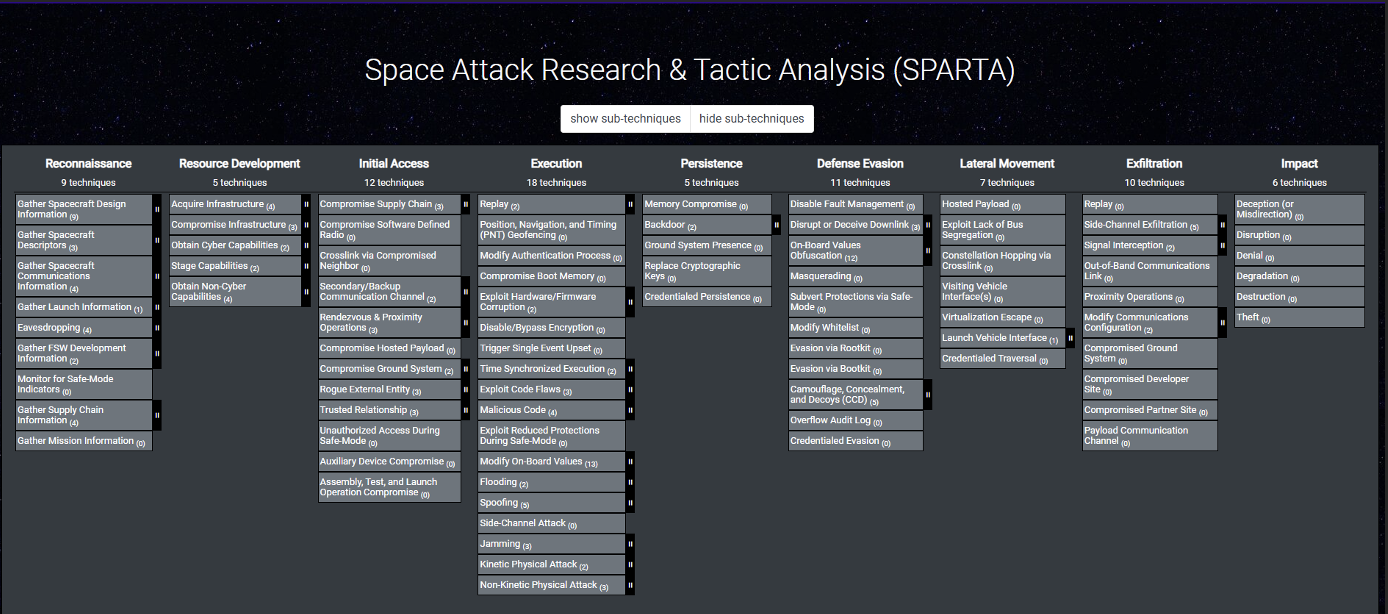
Expanding the drop-down menus at the top reveals the following:




There is a search bar to help users find information easily. The example below shows some results when searching for information on SPARTA Techniques:
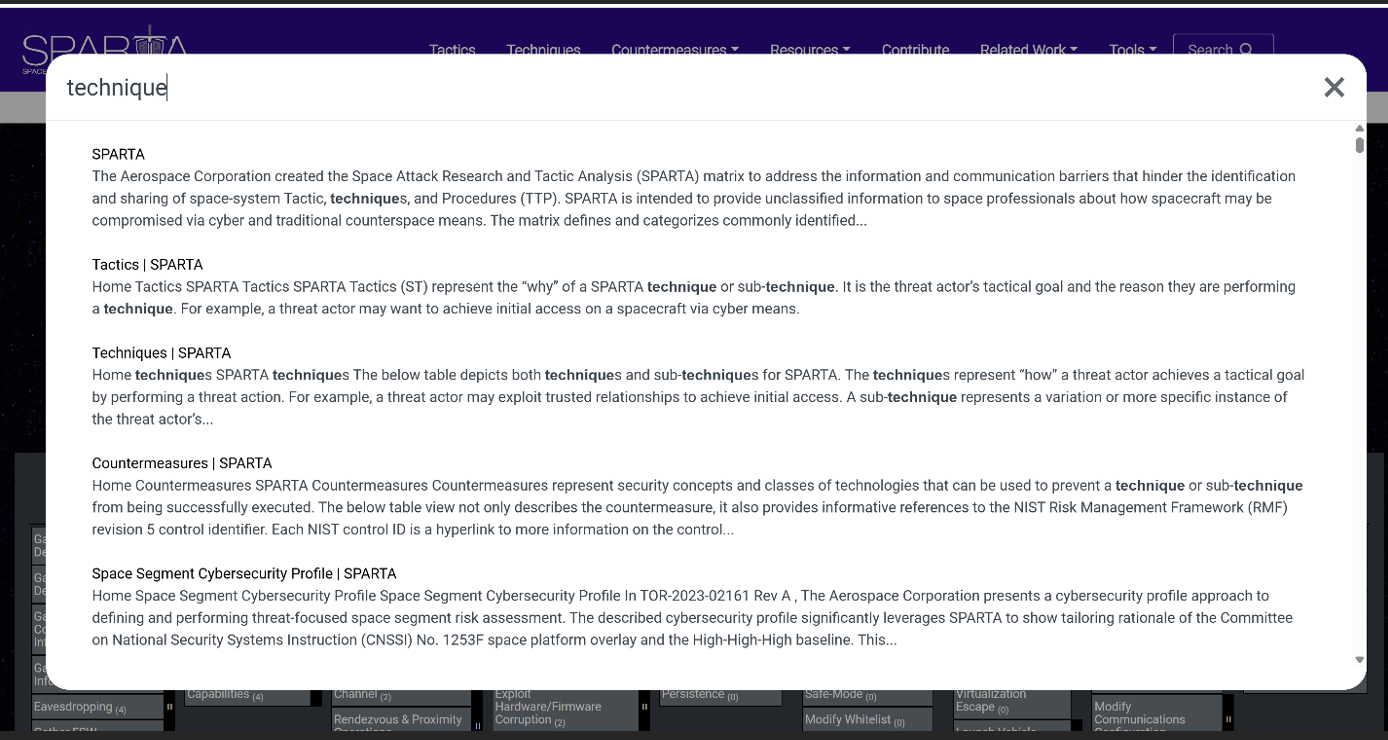
Tactics and Techniques
Tactics
Tactics represent the threat actor’s tactical goal and the reason(s) they are performing a technique. For example, a threat actor may want to achieve initial access on a spacecraft via cyber means. Other tactics include reconnaissance, resource development, execution, defense evasion, exfiltration, lateral movement, and impact.
The SPARTA Tactics page provides detailed information on Tactics with associated Techniques and Sub Techniques that help achieve the goal of the Tactic. On the left-hand side there is a menu layout to help users isolate information for each Tactic.
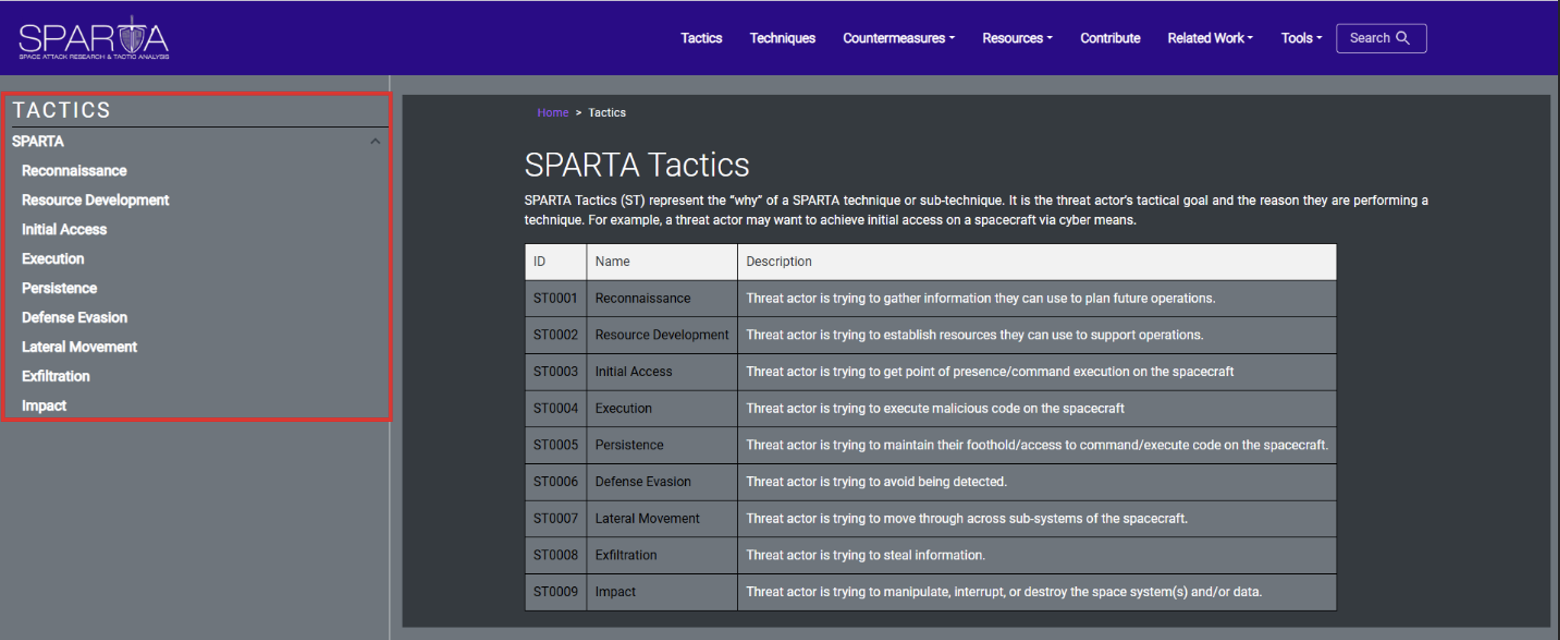
For example, the Reconnaissance Tactic has the primary Technique of Gathering Spacecraft Design Information which has several Sub Techniques such as Software Design:

Techniques & Sub-techniques
Techniques represent “how” a threat actor achieves a tactical goal by performing a threat action. For example, a threat actor may exploit trusted relationships to achieve initial access. SPARTA maps a range of techniques that threat actors can use to execute tactics.
The Techniques page follows the same navigation pane style as the Tactics, allowing users to easily isolate information on Techniques.
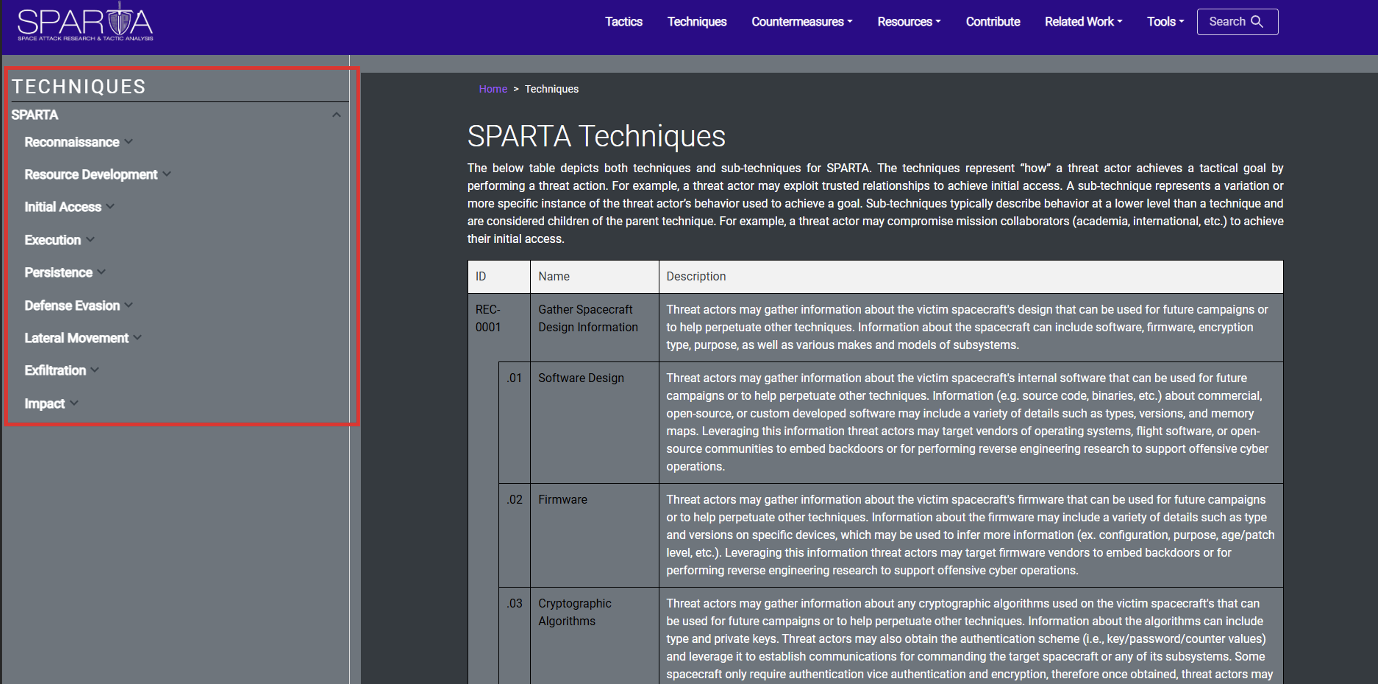
Sub-techniques represent a variation or more specific instance of the threat actor’s behavior used to achieve a goal. Sub-techniques typically describe behavior at lower levels than a technique and are considered children of the parent technique. For example, the Software Design Sub Technique has the Parent Technique of Gather Spacecraft Design Information:
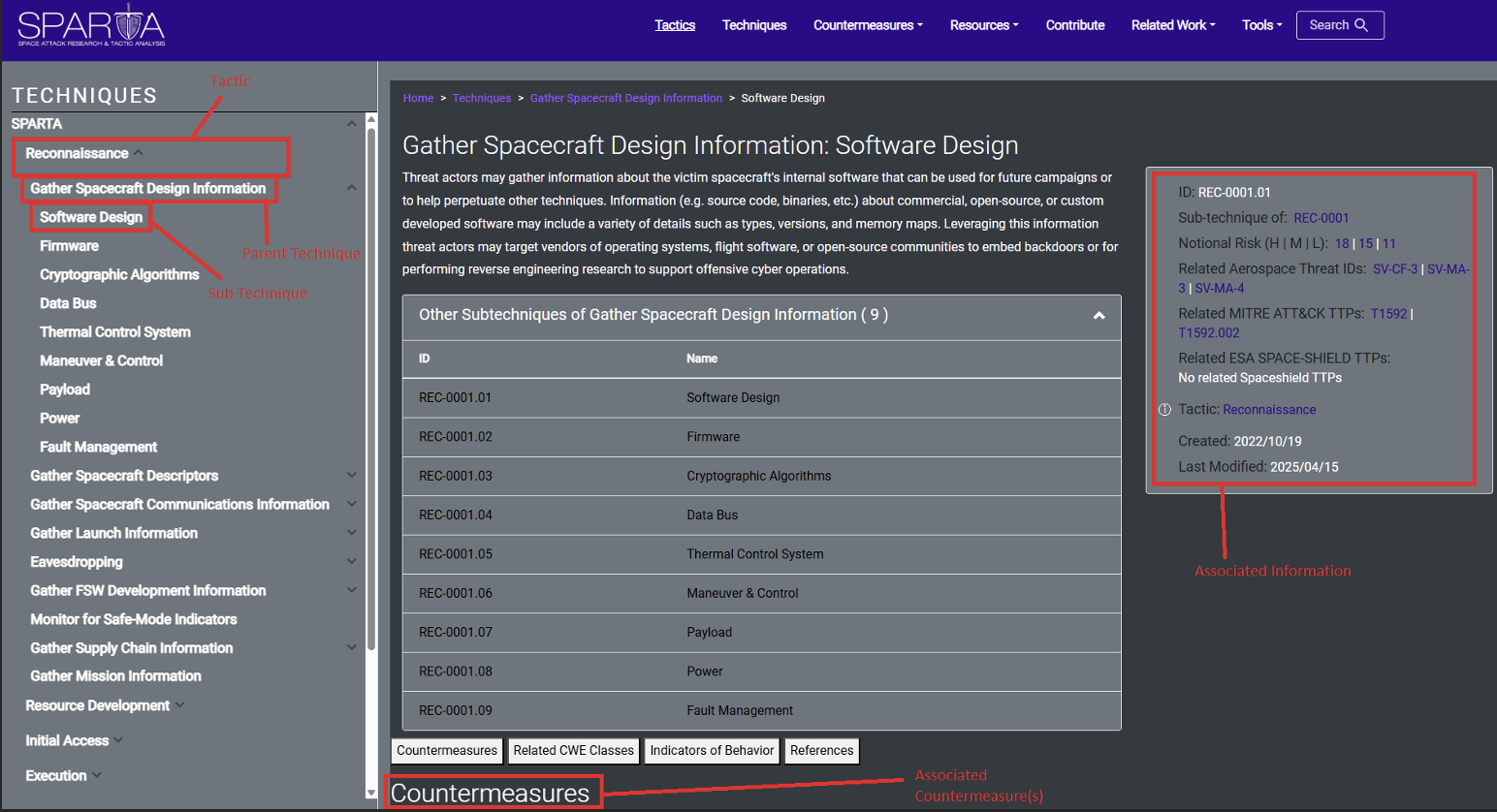
Notional Risk Score (NRS)
Nearly every technique and sub-technique within SPARTA has an assigned Notional Risk Score (NRS). The intention of NRS is to provide practitioners with a starting point for space cyber risk management, from which they can apply specific details (e.g., a reference architecture) to tailor the NRS to better represent their system.
The scores are derived from the resulting impact and likelihood of the SPARTA technique on a 5x5 risk matrix. The matrix provides a risk score with respect to an assessed impact score from 1 to 5 (the x-axis) and a likelihood score from 1 to 5 (the y-axis); the risk scores are shown in the respective cells of the matrix and reflect the joint effect of impact and likelihood, according to the 5×5 matrix defined in NASA-S3001: Guidance for Risk Management.
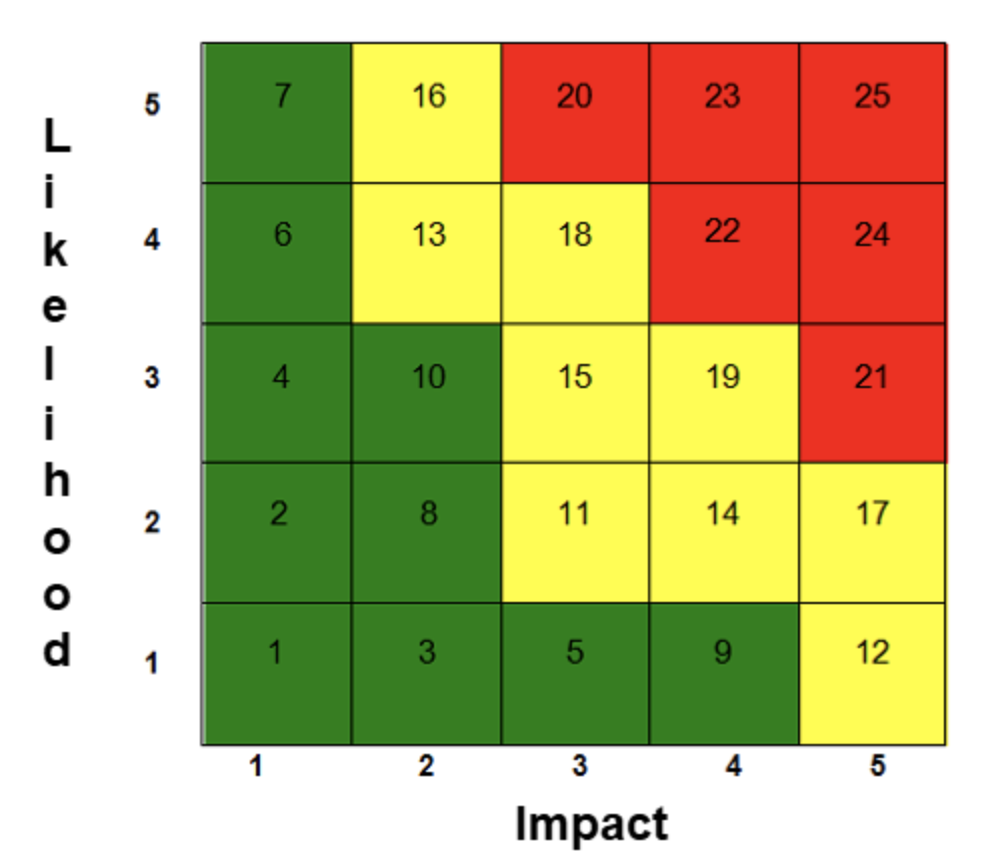
Risk scores range from 1 to 25 but are not the product of likelihood and impact. The scores are a result of which cell the technique falls under after using the respective 1 to 5 score for both likelihood and impact. Risk scores ranging from 1 to 10 are considered low (green), 11 to 19 considered medium (yellow), and 20 to 25 considered high (red). Each technique displays three distinct NRS values based on the criticality of the hypothetical system in question. Ranging from 1-25, each of these three distinct values are presented on the applicable SPARTA TTP pages as Notional Risk (H | M | L): High Criticality System Risk # | Medium Criticality System Risk # | Low Criticality System Risk #.
Onboard Indicators of Malicious Behavior
Indicators of Compromise (IOCs) and Indicators of Behavior (IOBs) play pivotal roles in threat detection and mitigation. However, the distinct characteristics of these indicators and their applications often require nuanced understanding, especially within complex environments like space systems. The initial development and spearheading of the IOB work in SPARTA was funded by the Department of Homeland Security (DHS) Science and Technology Directorate to advance proactive detection capabilities tailored to the unique needs of the space domain.
Top 10 IOB Categories
-
Unauthorized and Anomalous Command Execution (UACE)
UACE IOBs focus on detecting unauthorized, anomalous, or malicious command executions targeting spacecraft operations. It includes monitoring commands issued outside expected time windows, deviations from baseline configurations, and replay attacks. UACE also covers unauthorized actions during safe-mode, where reduced security measures can be exploited. These IOBs help spacecraft operators identify and respond to command-related anomalies that may jeopardize mission integrity.
-
Unauthorized Cryptographic Key Usage and Encryption Bypass (UCEB)
UCEB IOBs target unauthorized access, misuse, or tampering with cryptographic keys and encryption mechanisms. Monitoring includes repeated cryptographic key usage from unexpected locations, improper access to decryption keys, and any unexpected changes to encryption configurations. UCEB IOBs are critical for detecting persistent access attempts or data exfiltration efforts that exploit weakened encryption practices.
-
Communication Security and Network Exploitation (CSNE)
CSNE IOBs detect unauthorized access and exploitation targeting spacecraft communication channels. They include monitoring network traffic from rogue ground stations, unexpected protocols, or IP addresses, as well as bandwidth spikes or communication link anomalies that might indicate jamming or network exploitation. By focusing on communication integrity, CSNE IOBs help detect potential command injection and data interception threats.
-
Authentication and RF Signal Integrity Threats (ARFS)
ARFS IOBs focus on threats to authentication mechanisms and RF communication integrity. This includes monitoring for abnormal authentication attempts, RF signal manipulation, and replay attacks. This category is vital for identifying electronic warfare tactics designed to compromise spacecraft control through signal jamming or spoofing.
-
GNSS and Time Manipulation Threats (GNTM)
GNTM IOBs focus on GNSS and timing data, which are critical for spacecraft navigation and synchronization. This category includes IOBs for detecting GNSS interference, time spoofing, and irregularities in time synchronization that may indicate manipulation. Monitoring for GNSS signal delays, signal-to-noise ratio drops, or unauthorized time adjustments helps maintain mission accuracy and stability.
-
Spacecraft Memory Integrity and Resource Exploitation Attacks (MIRE)
MIRE IOBs focus on unauthorized memory access or modification, including attacks on flash memory, EEPROM, and boot processes. They also cover resource exploitation tactics, such as memory exhaustion or the insertion of malicious code into boot memory. Detecting these threats helps protect critical system functions from disruption and unauthorized control.
-
Watchdogs and Register Exploitation (WTRE)
WTRE IOBs address threats to watchdog timers and critical subsystem registers. IOBs include detecting unauthorized access or manipulation of watchdog functions that may disrupt spacecraft stability. Monitoring for changes to critical registers or timing inconsistencies helps identify potential sabotage or subsystem compromise.
-
Software Integrity and Unauthorized Updates (SIUU)
SIUU IOBs detect the manipulation or unauthorized modification of flight software, including malicious updates or firmware tampering. Monitoring includes checking software integrity, update validation, and unauthorized software modifications. This category helps ensure that software configurations remain secure throughout the spacecraft’s operational life.
-
Spacecraft Sensor Manipulation and System Resource Exploitation (SMSR)
SMSR IOBs address threats to spacecraft sensors, which are critical for attitude control and system monitoring. SMSR IOBs detect manipulation of sensor data or attempts to exploit system resources. Examples include false telemetry injection or sensor spoofing that may mislead spacecraft operations. Early detection helps maintain accurate control and prevents resource depletion.
-
Data Integrity and Storage Exploitation Threats (DISE)
DISE IOBs focus on maintaining data integrity and protecting onboard storage from unauthorized modification or data corruption. DISE IOBs monitor file system integrity, data manipulation attempts, and unauthorized data deletions. By securing critical data, spacecraft operators can protect mission continuity and prevent data loss.
Building Intrusion Detection Systems with IOBs
One of the key applications for IOBs is in building and enhancing Intrusion Detection Systems (IDSs) for spacecraft. Some IDSs solutions rely only on signature-based detection via IOCs, which may not suffice in a rapidly evolving threat landscape. With IOBs, IDS can be properly tuned to detect behavioral anomalies, such as unauthorized command execution during safe-mode or unexpected memory modifications. By integrating these IOBs into onboard IDSs, spacecraft operators gain the ability to detect not just known threats but also emerging patterns that could indicate compromise. This level of detection is critical for maintaining mission assurance in the face of sophisticated cyber adversaries.
Integrating IOBs directly into spacecraft, we can address emerging cyber threats and ensure continuous protection, even when communication with ground stations is delayed or interrupted. The development of onboard intrusion detection will become a critical piece in space system defense strategies, helping protect against malicious activities, system manipulation, or protocol-based attacks that can compromise spacecraft operations. Given how quickly an attack can manifest onboard, ground operators may not have time to intervene before they lose control of the spacecraft. In this evolving threat landscape, the move towards on-orbit, autonomous cyber defense capabilities is essential to safeguard future space missions. Having documented IOBs will greatly enhance the detection, correlation, and response capabilities of these platforms by monitoring for specific malicious or anomalous behaviors in spacecraft operations.
To effectively leverage IOBs in intrusion detection, we chose to document them using the Structured Threat Information Expression (STIX) format. STIX is particularly well-suited for capturing behavioral indicators because its flexible and expressive structure allows for detailed representation of complex threat patterns. By using STIX, we provide a standardized way to define IOBs that can be directly integrated into IDS implementations. This approach not only enhances consistency but also supports the creation of detection logic. Feedback from the community has highlighted that the STIX format, with its Boolean and pattern-matching capabilities, greatly facilitates building automated detection rules, helping spacecraft software developers quickly build detections for indicators.
For these IOBs to be effective in detecting threats or anomalies in spacecraft operations, it is essential that the necessary data is available for analysis. Without access to critical telemetry, network traffic logs, process activity, and other system data, even the most sophisticated detection logic will be rendered useless. The spacecraft must ensure that this data is collected, transmitted, and stored in a reliable manner so that it can be analyzed in real-time. This includes having robust logging mechanisms in place to capture communication protocols, system resource usage, file integrity, and command execution events. Data availability is the foundation of any detection and response strategy and without it, the visibility needed to identify threats is impaired, leaving the spacecraft vulnerable to undetected attacks.
Countermeasures and Secure-by-Design Principles
Educating the space community on spacecraft tactics, techniques, and procedures (TTPs) is one goal of SPARTA, but equally important is ensuring space system engineers are informed about countermeasures available to aid in mitigation.
While TTPs are important to understand a threat actor’s “why” and “how,” ensuring relevant technical and administrative countermeasures are in place is imperative. According to NIST, countermeasures are defined as “protective measures prescribed to meet the security objectives, i.e., confidentiality, integrity, and availability, specified for an information system. Safeguards may include security features, management controls, personnel security, and security of physical structures, areas, and devices”.
In the context of a spacecraft, some example countermeasures include protecting spacecraft design information from exfiltration, applying more rigor to the hardware/software supply chain, ensuring communication security (COMSEC) and/or transmission security (TRANSEC), or implementing better segmentation for mission-critical data flows onboard the spacecraft bus.
SPARTA provides countermeasures against tactics and their supporting techniques. These countermeasures will be enhanced over time as new TTPs are published and space-cyber defensive technology matures.
SPARTA countermeasures are grounded in experience and industry standards, drawing from sources like Security and Privacy Controls for Information Systems and Organizations (NIST SP 800–53 Rev. 5), whenever those controls are relevant in space-cyber contexts. SPARTA leverages The Aerospace Corporation’s defense-in-depth (DiD) model for space systems, as described in the paper, Cybersecurity Protections for Spacecraft: A Threat Based Approach.
As is the case with the tactics and techniques, a pane on the left-side of the page can be used to navigate this content, which is sorted according to the DiD layers:
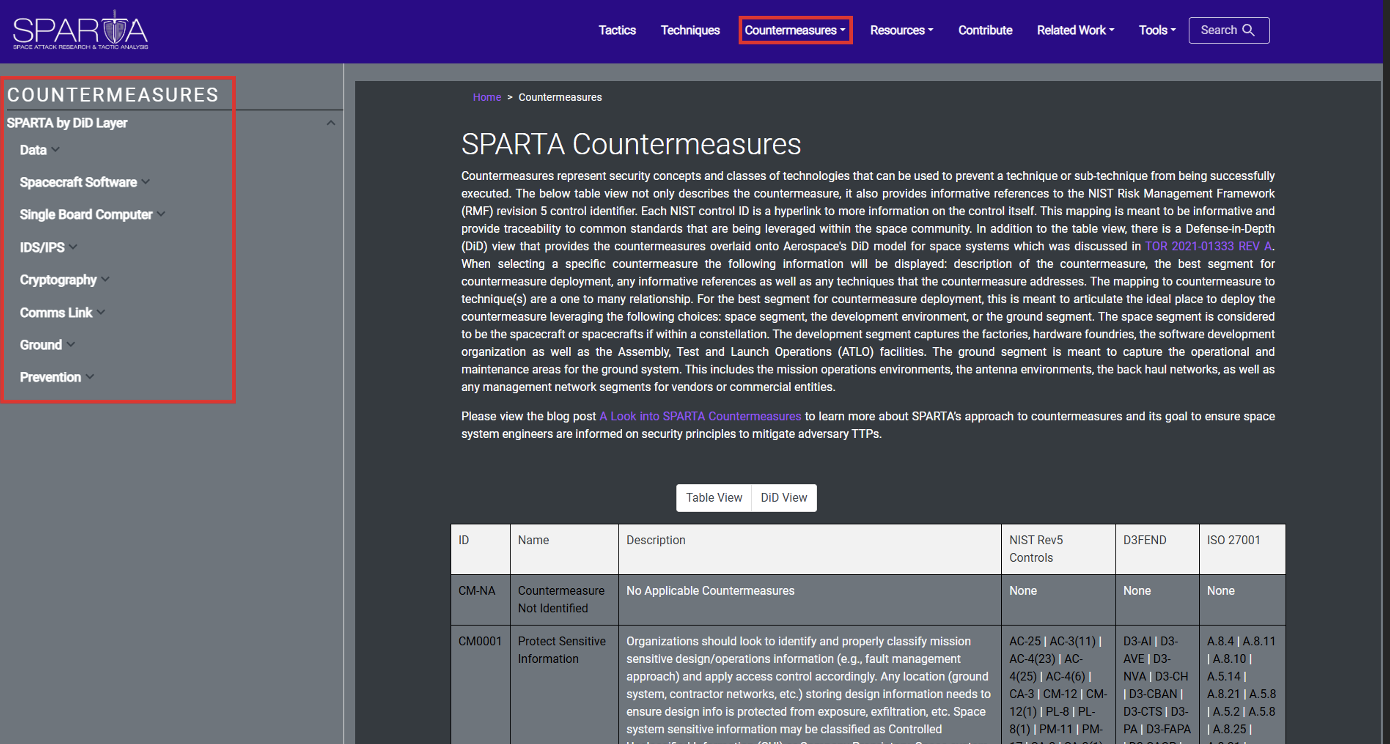

Each Countermeasure is mapped to relevant NIST control(s), technique(s) and Indicators of Behavior (IOBs)
Using the above example of the TEMPEST Countermeasure, if you were to scroll down on the web page and interact with the “Mappings” button, you would see all the controls the Countermeasure is mapped to:
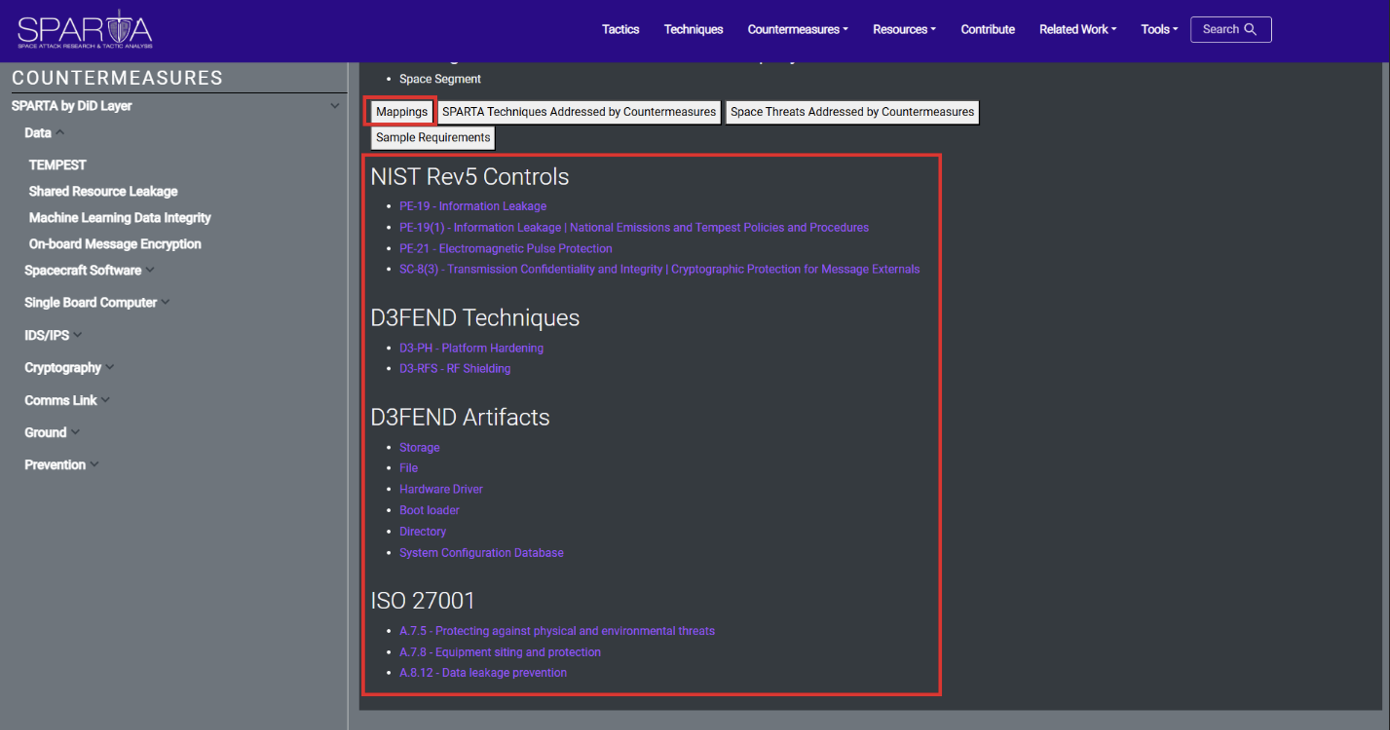
Users can toggle various supplemental content with the buttons on the page as shown below.
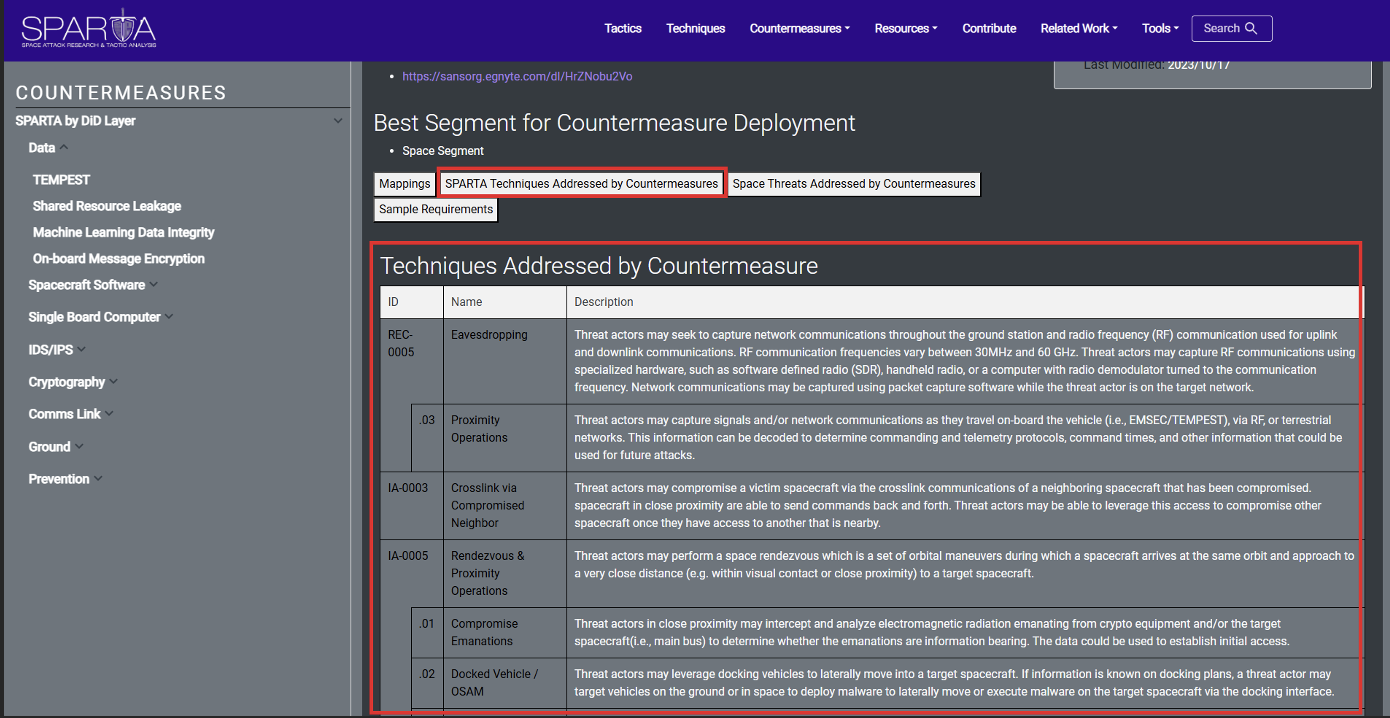
Lastly, the “Sample Requirements” button will reveal sample acquisition language/engineering requirements (shall statements) that could be used to help design a system feature that meets the intent of the countermeasure:

Common Weakness Enumeration (CWE) Integration: Deep Dive
The integration of CWE mappings to SPARTA is paramount in supporting the Secure by Design philosophy. CWE is a class-based category system for hardware and software weaknesses and vulnerabilities. The addition of CWE classes mapped to SPARTA techniques reflects the understanding that all adversary techniques fundamentally target weaknesses within spacecraft. Mapping techniques to CWE classes allows us to establish a clear link between specific attack methods and the underlying weaknesses they exploit.
Each SPARTA Technique is mapped to a CWE Class. This allows developers to better understand what CWE Classes threat actors are likely targeting, and where developers may want an additional level of scrutiny when designing space systems.
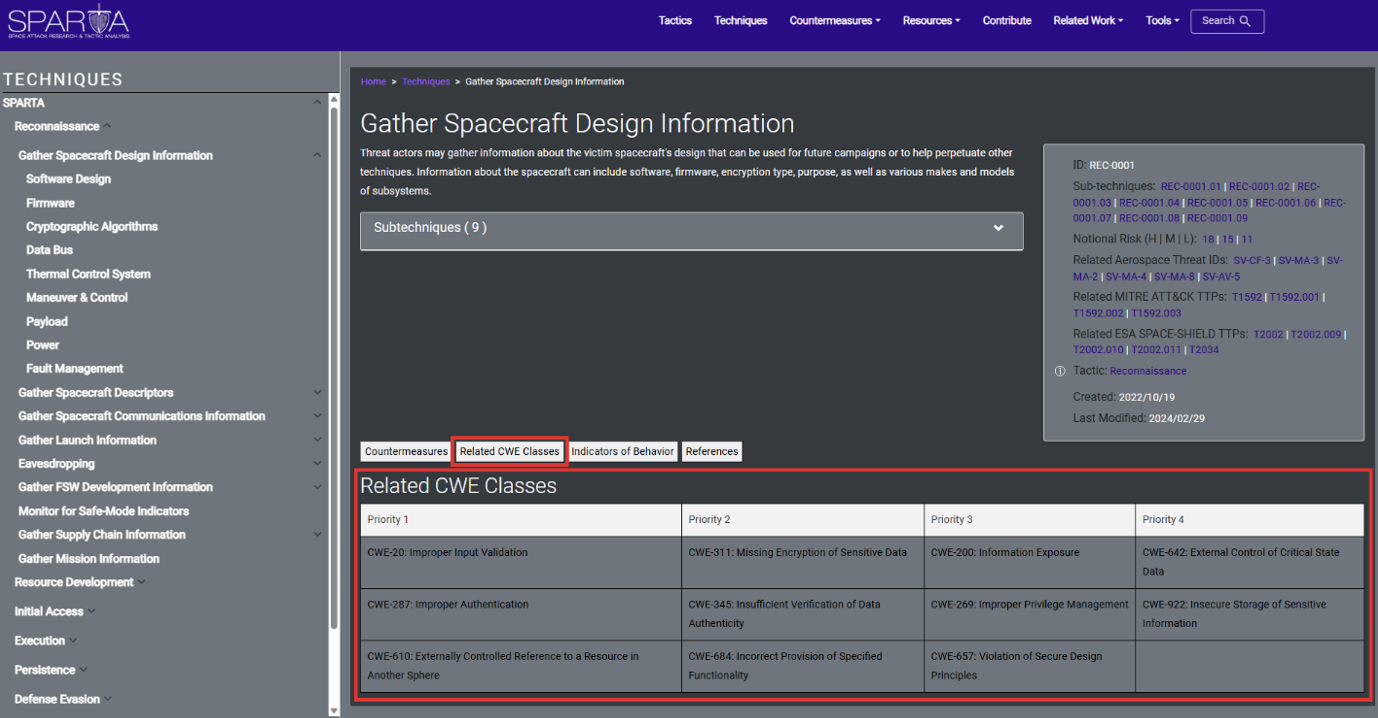
As seen above, the “Gather Spacecraft Design Information” technique is mapped to several CWE Classes among 4 levels of priorities. Indicating that for the “Gather Spacecraft Design Information” Technique, an adversary would be looking for these kinds of misconfigurations and vulnerabilities in the design of a spacecraft. The CWE mapping helps guide developers in understanding how an adversary looks for weaknesses in a spacecraft per technique, helping drive home the Secure by Design philosophy.
SPARTA Tool Tutorials
SPARTA has a number of built in tools to help users work with the vast amount of data contained on the site. Below you will find brief overviews for each.
SPARTA Navigator
The SPARTA navigator can be found here. The SPARTA navigator is a tool for creating SPARTA attack chains or highlighting TTPs. It can be used to visualize countermeasure coverage, red/blue team planning, and more. The user can create their own layers in JSON and load them later to visualize attack chains, coverage maps, etc. The most important feature of SPARTA’s Navigator is the ability to export information into Excel. This enables users to select TTPs and then export all of the associated data points for their attack chains, to include the countermeasure(s), associated TTPs/threats, NIST control mappings, and much more.
The SPARTA Navigator page:
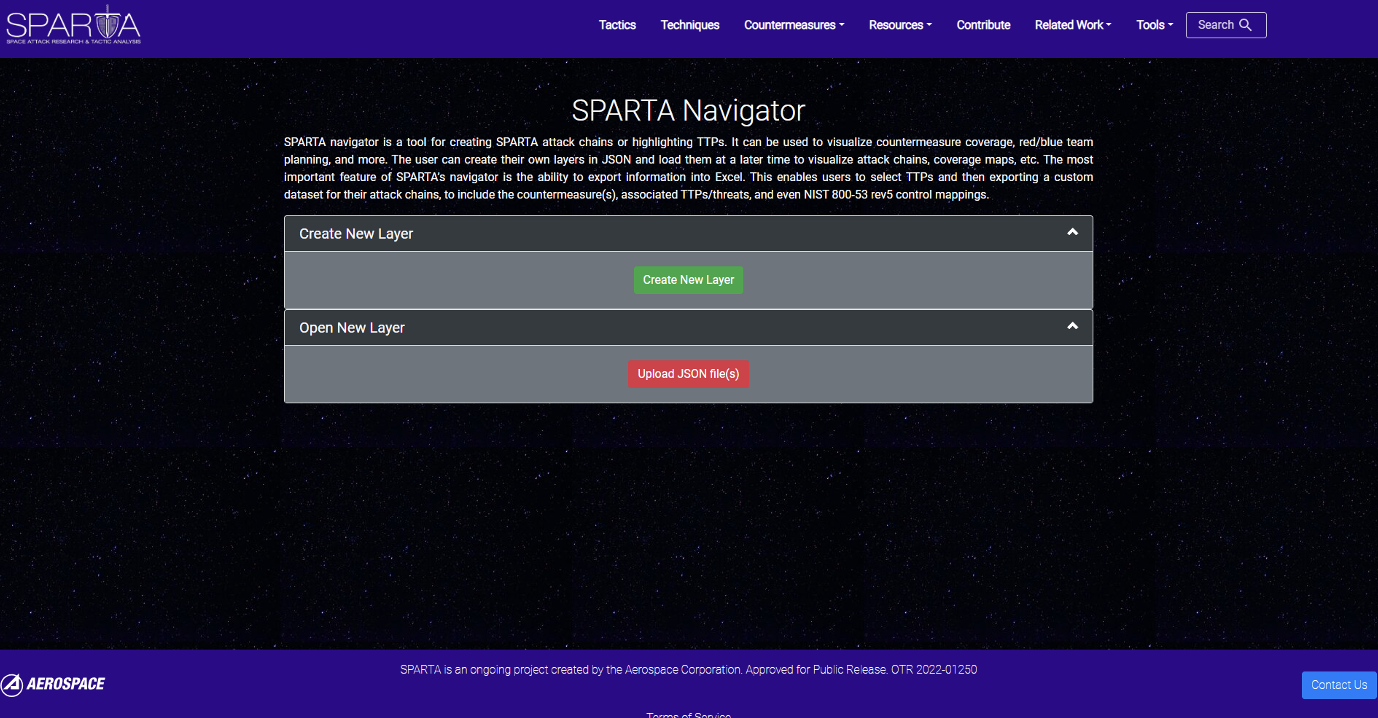
To create a new layer simply click the button:
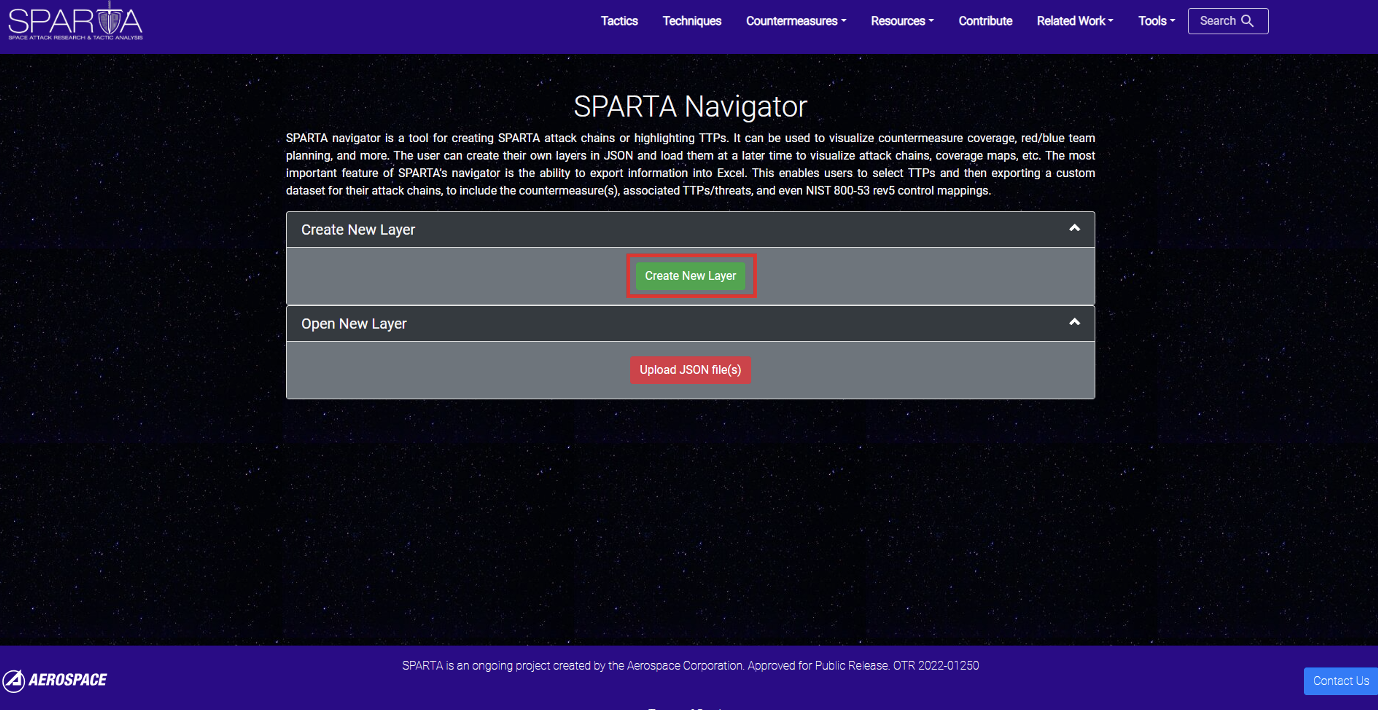
Upon opening a new layer, the following page is loaded:
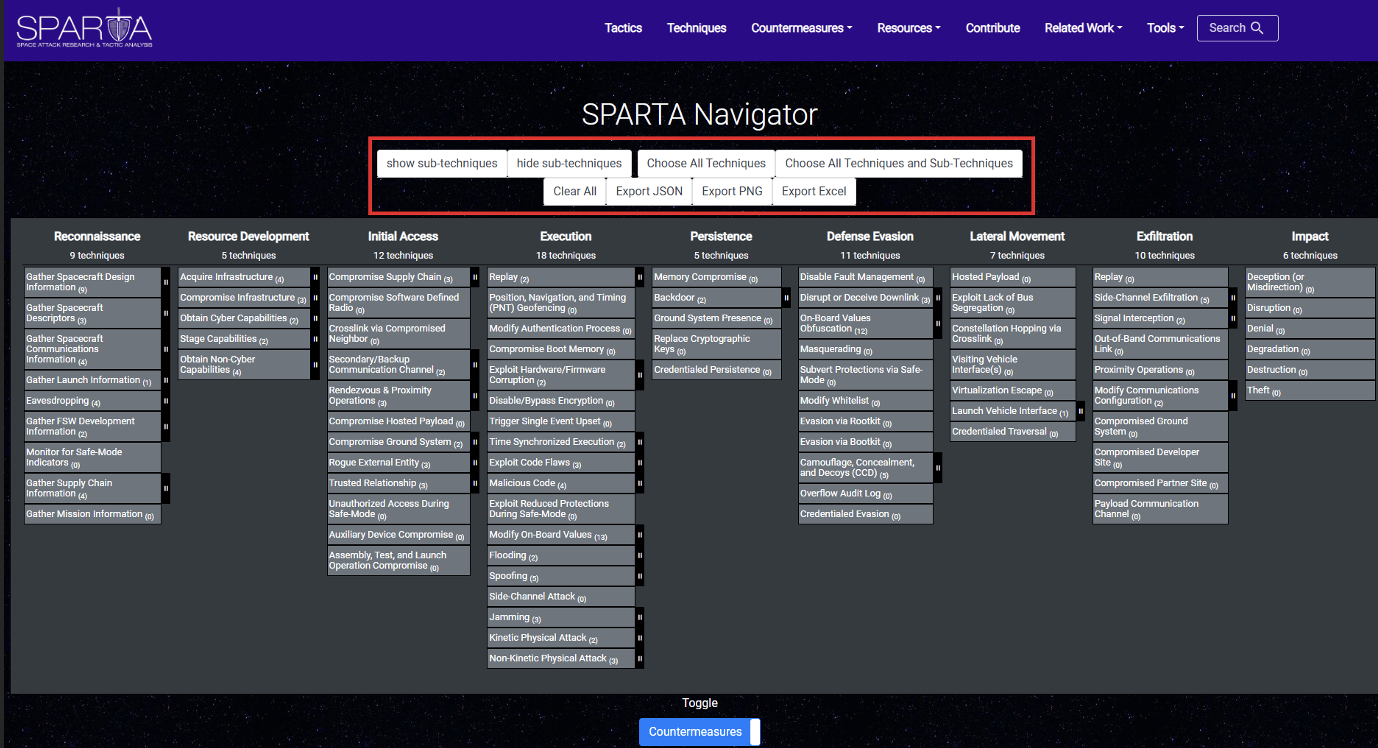
But to utilize the SPARTA Navigator, first click a TTP to reveal the associated countermeasure(s)/NIST Control(s), in the below example the “Eavesdropping” technique was selected:
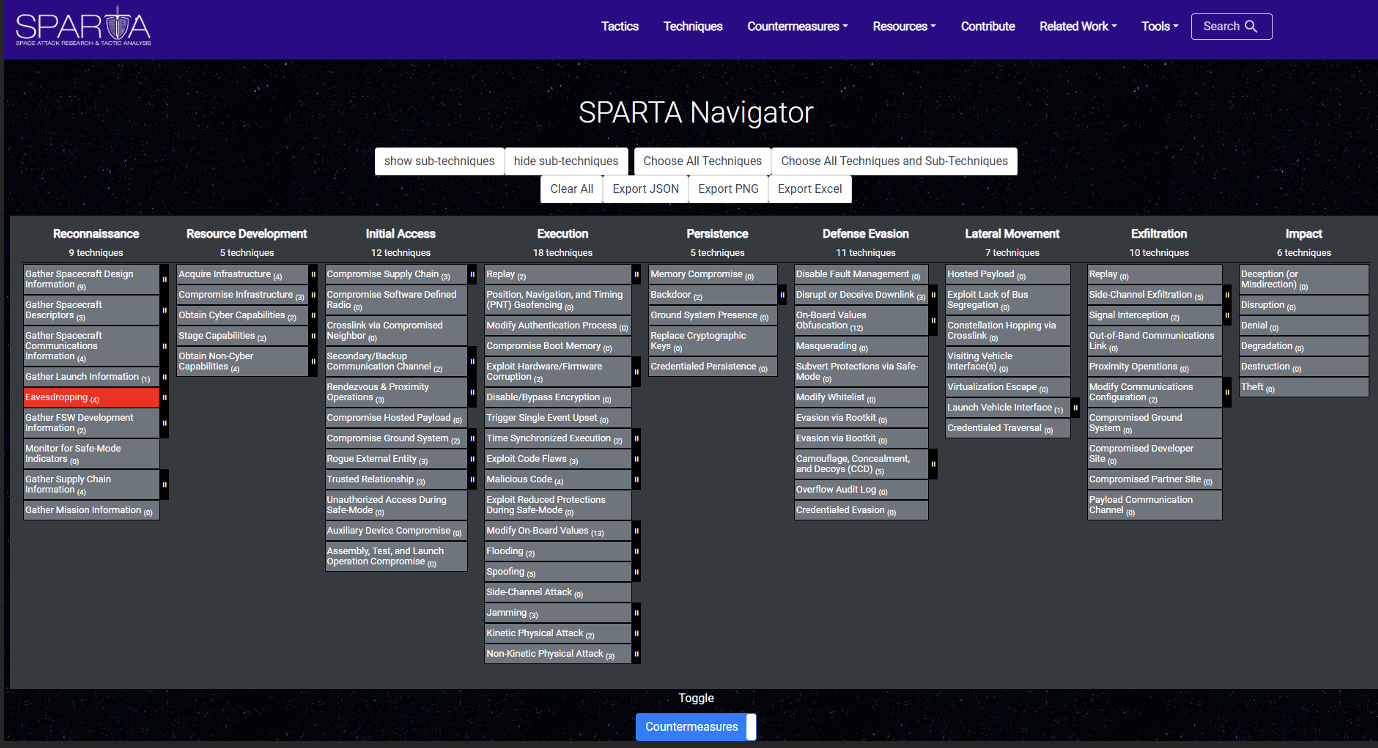
Next, scroll down and utilize the toggle button to switch between the countermeasure(s) and NIST controls associated to the TTP(s)
In the below image the countermeasures were toggled on, and the countermeasures associated to the “Eavesdropping” TTP are highlighted in green:
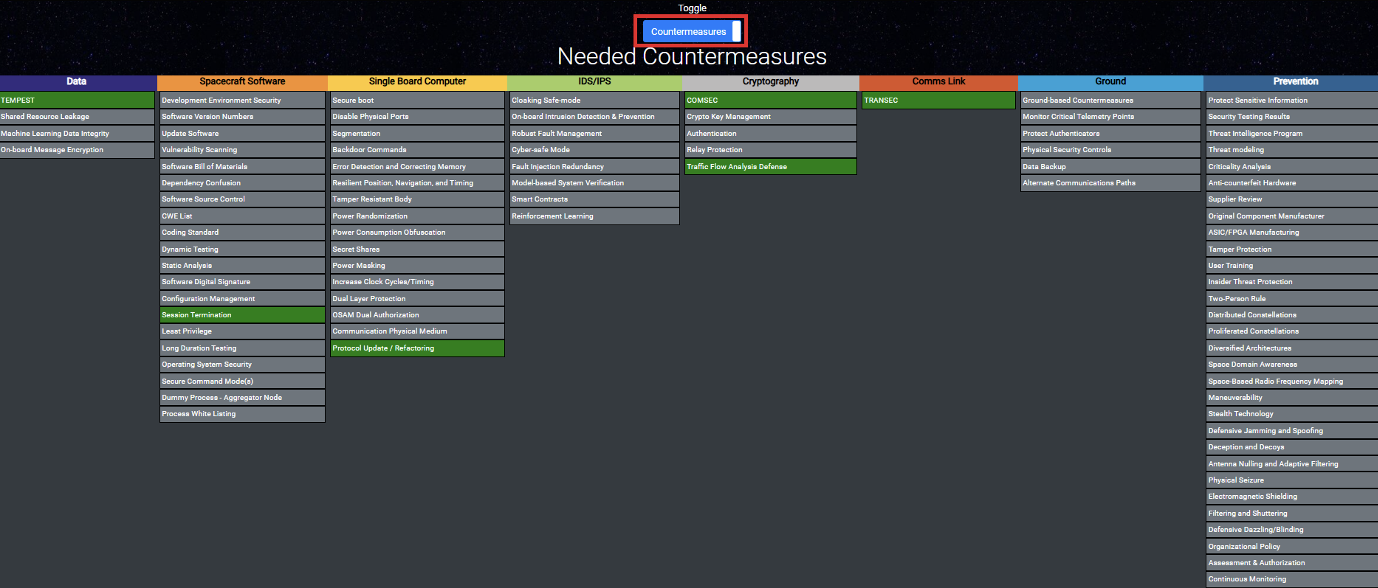
And to see the associated NIST controls, simply click the toggle button:
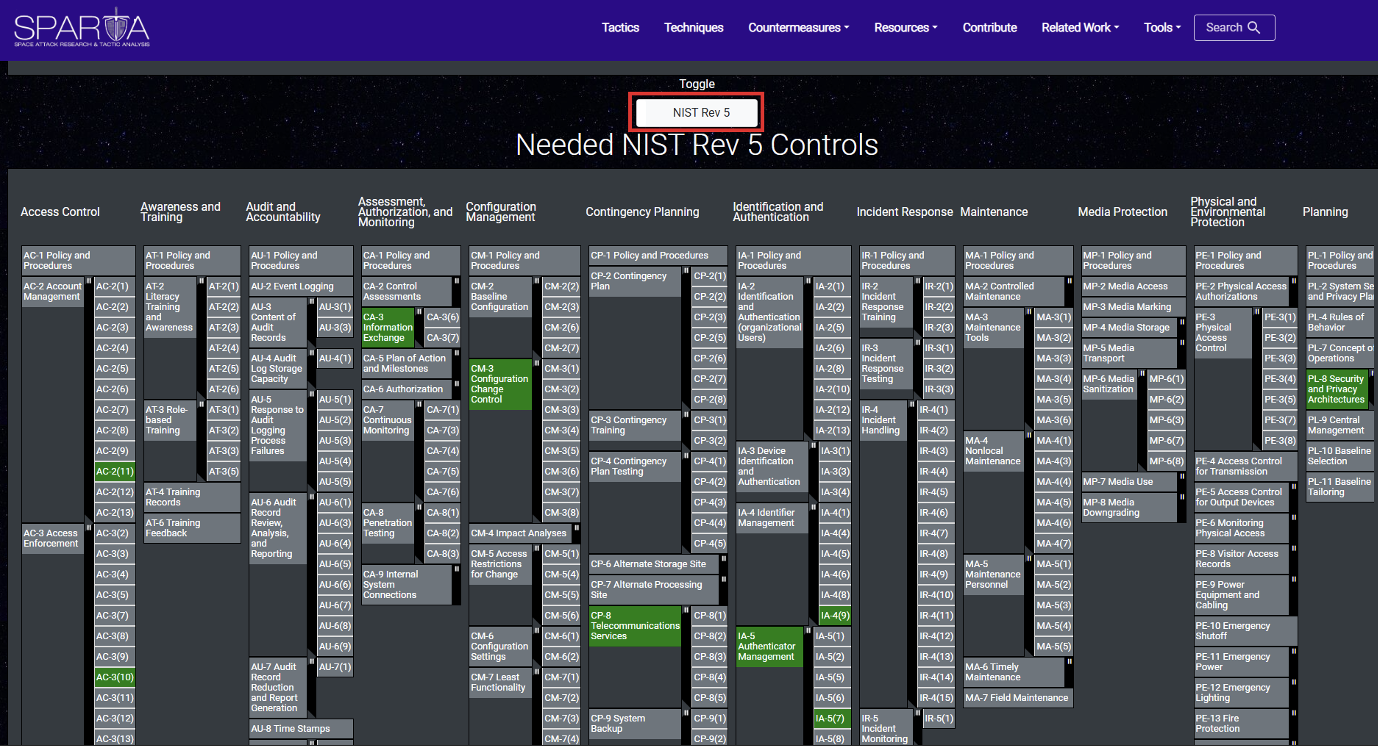
Countermeasure Mapper
The countermeasure mapper enables the user to select countermeasure(s) using the Defense-in-Depth view to visually determine their coverage of SPARTA techniques/sub-techniques. This feature is particularly useful when chaining together countermeasures to build a security architecture for the spacecraft. Before selecting any countermeasures, all the techniques/sub-techniques will appear in red but as the user selects a countermeasure, the techniques/sub-techniques turn green indicating some level of coverage and risk reduction. It is important to understand that a single countermeasure typically cannot fully prevent a TTP but it aides in risk reduction for the spacecraft. When finished selecting countermeasures, the user can export the TTP graphic but more importantly the user can export the data to Excel. The Excel workbook will report the selected countermeasures, the TTPs covered as well as the gaps in TTP coverage in respective tabs of the workbook. From a security engineering perspective, this will ensure system designers can better understand where their gaps and potential risk resides.
To create a new layer, simply use the “Create New Layer” button:
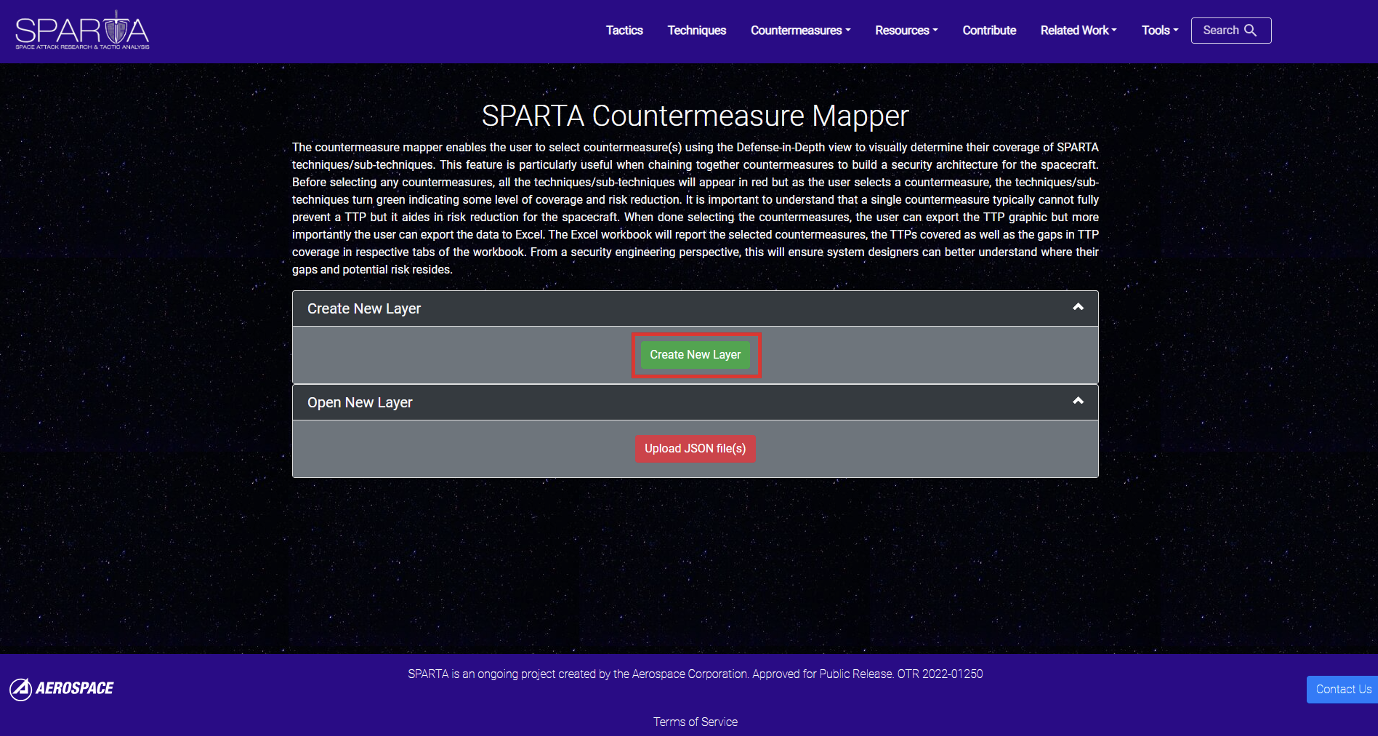
When creating a new layer, first select the countermeasure(s) of interest to see their associated TTP(s).
In the demonstration below, the first countermeasure of each category was selected. Each countermeasure selected will become green instead of grey:
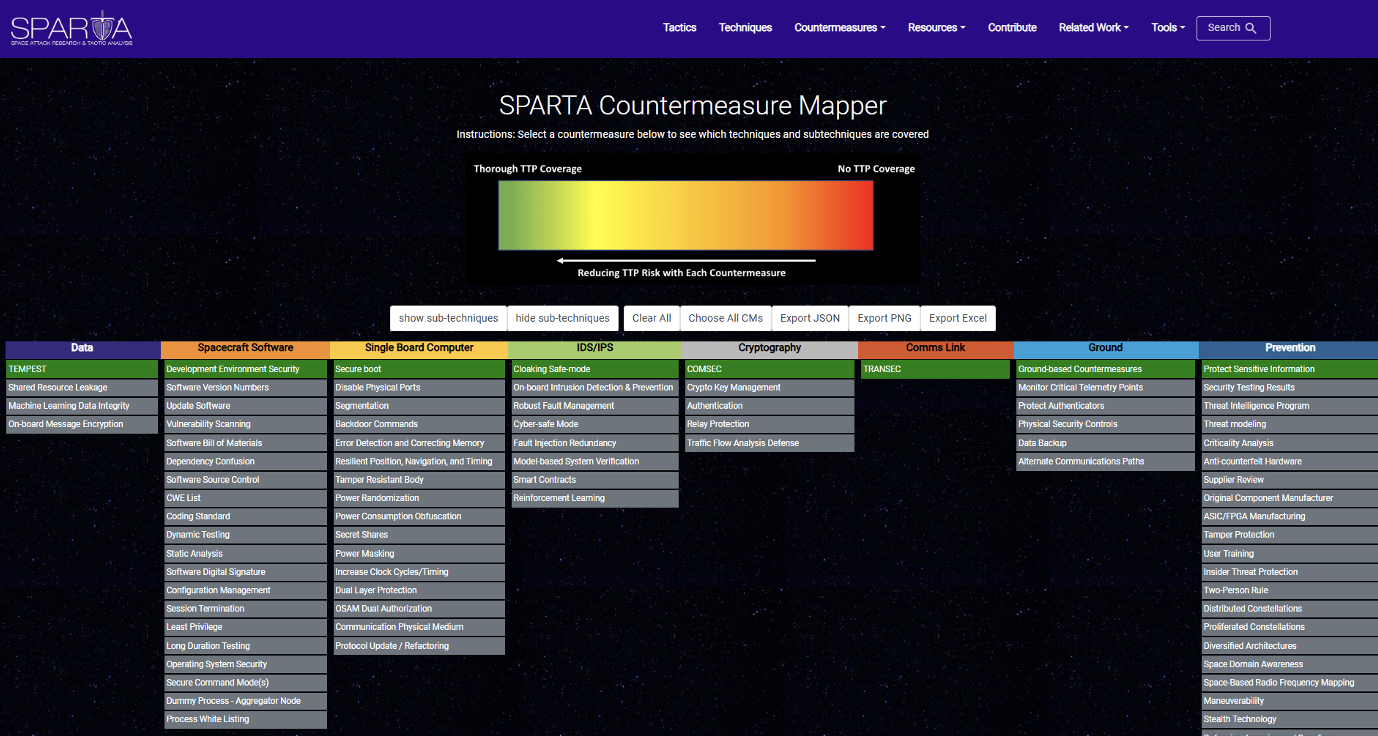
To see the impact this has on mitigating TTP(s) simply scroll down:
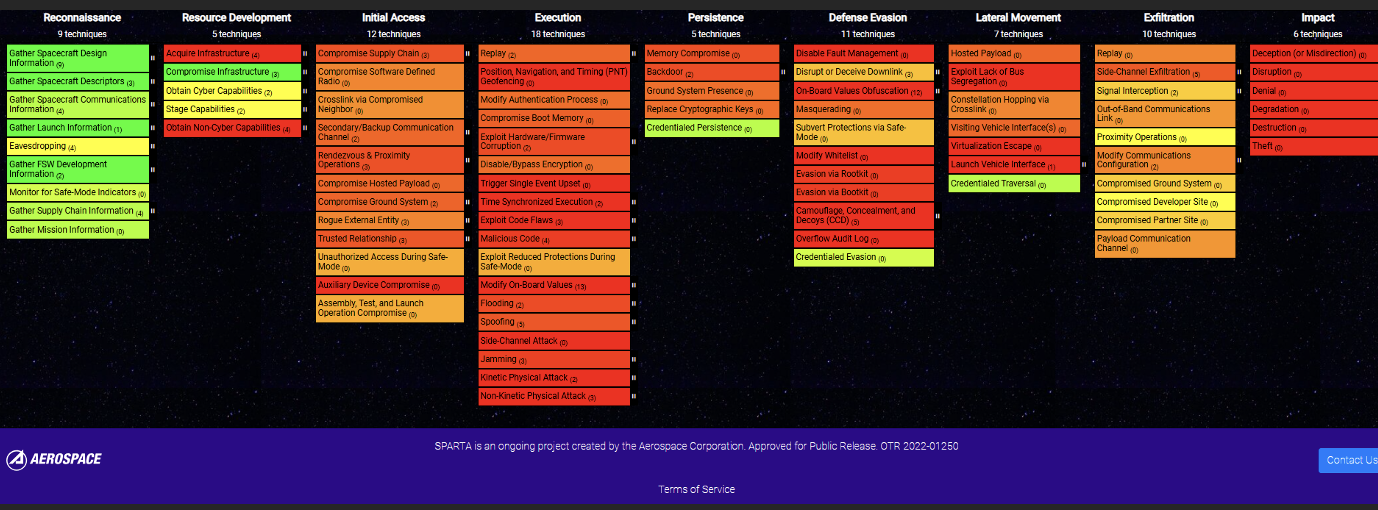
Notice the significant TTP coverage for the Reconnaissance tactic but there is little to no coverage regarding the other tactics. Remember to reference the below spectrum when analyzing TTP coverage:
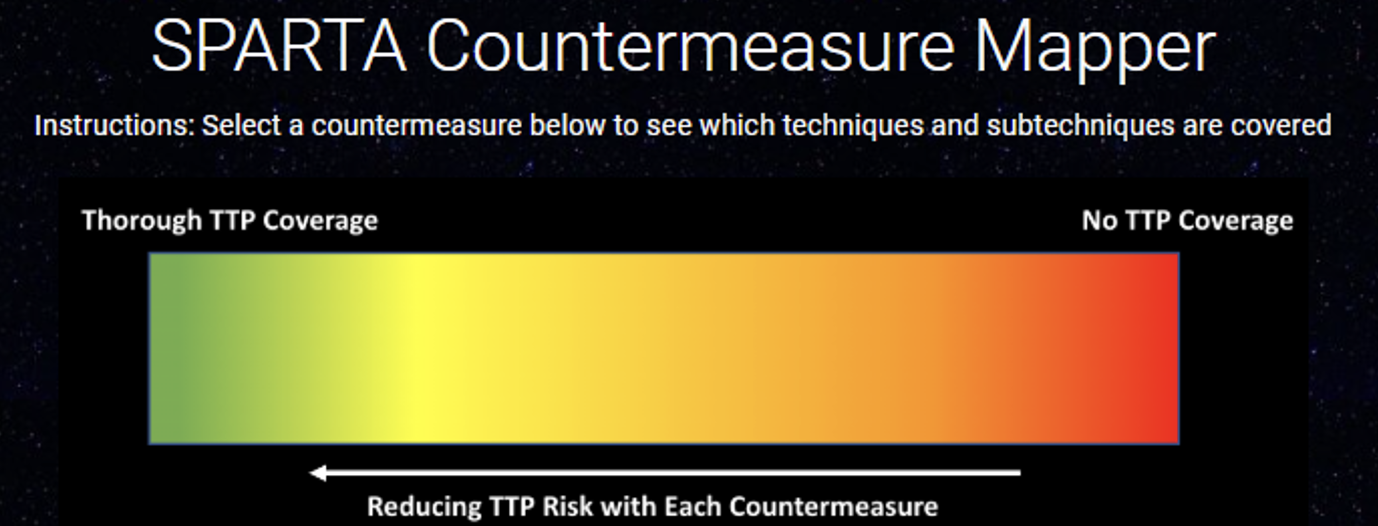
Control Mapper
The SPARTA control mapper enables the user to select individual NIST controls and enhancements, as well as ISO 27001 requirements/controls using graphical user interface. This feature is particularly useful when chaining together many controls to build a security architecture for the spacecraft.
Before selecting any control, all the techniques/sub-techniques will appear in red but as the user selects control(s), the techniques/sub-techniques turn green indicating some level of coverage and risk reduction. It is important to understand that a single control has little impact on a TTP within SPARTA. Because these controls are more granular than SPARTA countermeasures in general, it will take a multitude of controls to fully mitigate a TTP.
The functionality of the control mapper leverages the relationship between SPARTA countermeasures and controls that have been published under the countermeasure section of SPARTA.
When done selecting the controls, the user can export the TTP graphic but more importantly the user can export the data to Excel. The Excel workbook will report the selected controls, the TTPs covered as well as the gaps in TTP coverage in respective tabs of the workbook. From a security engineering perspective, this will ensure system designers can better understand where their gaps and potential risk resides.
In contrast to the SPARTA countermeasures, there are many more controls from a NIST or ISO perspective. Therefore, users can leverage the JSON creator tool to create their own custom overlays of controls vice manually selecting from the graphical interface.
The SPARTA Control Mapper:
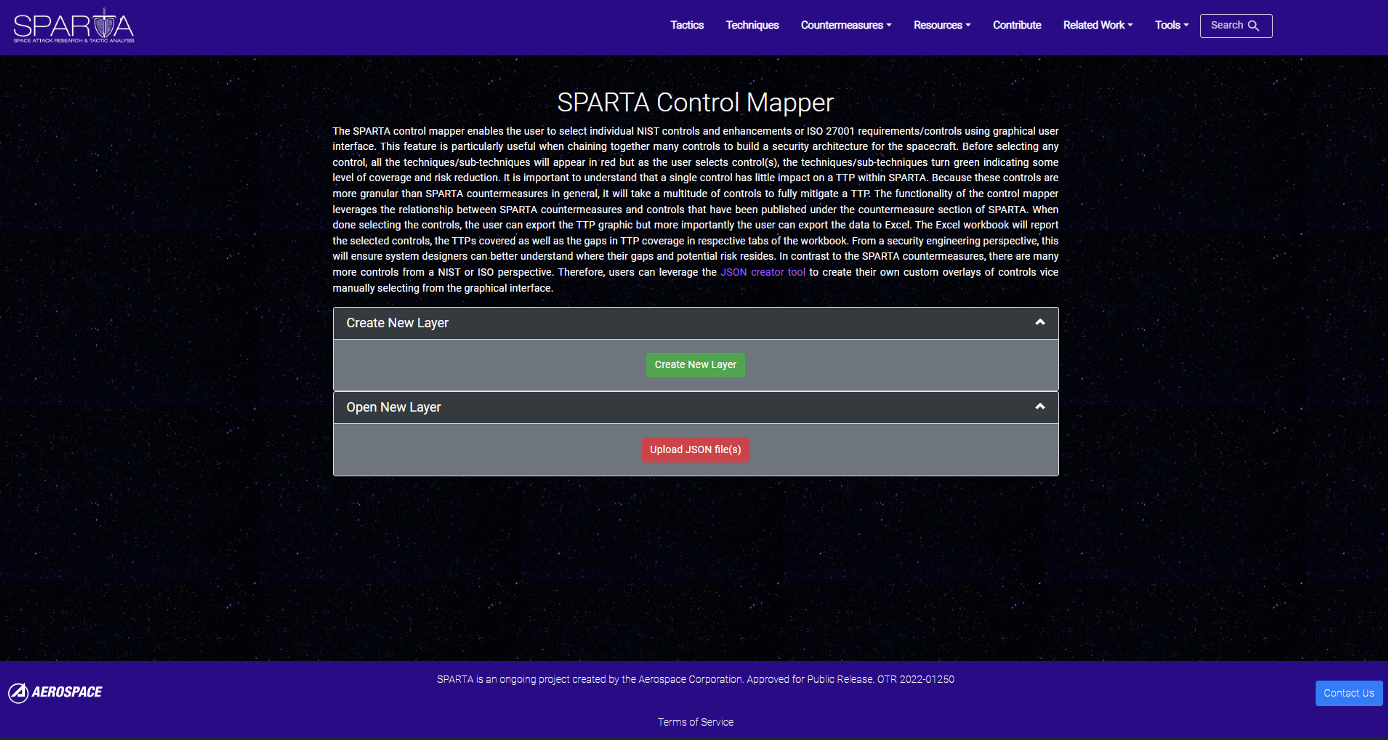
To create a new layer simply interact with the “Create New Layer” button:
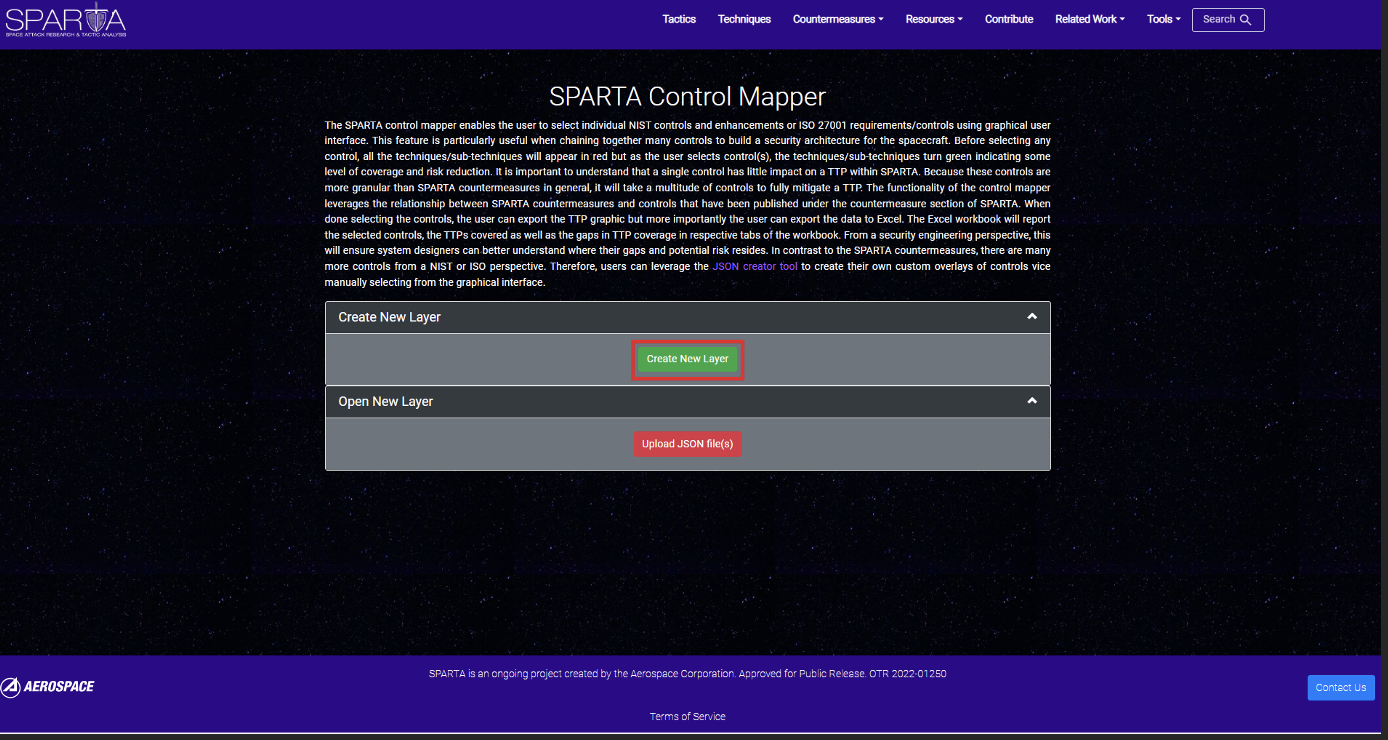
When creating a new layer, first select the Control Framework you would like to use for analysis:
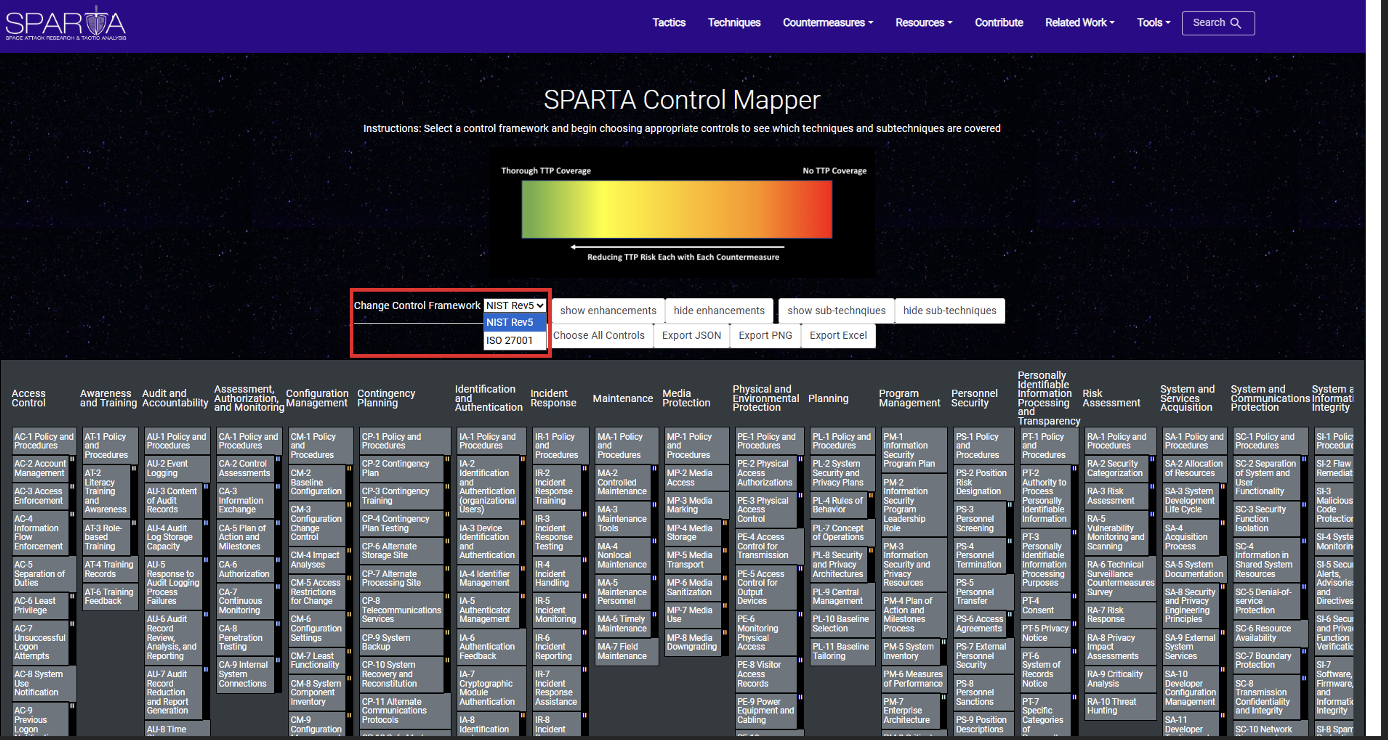
After your Control Framework is selected, start by selecting the control(s) you would like to evaluate.
For this demonstration, many controls were selected at random (the selected controls are marked green):
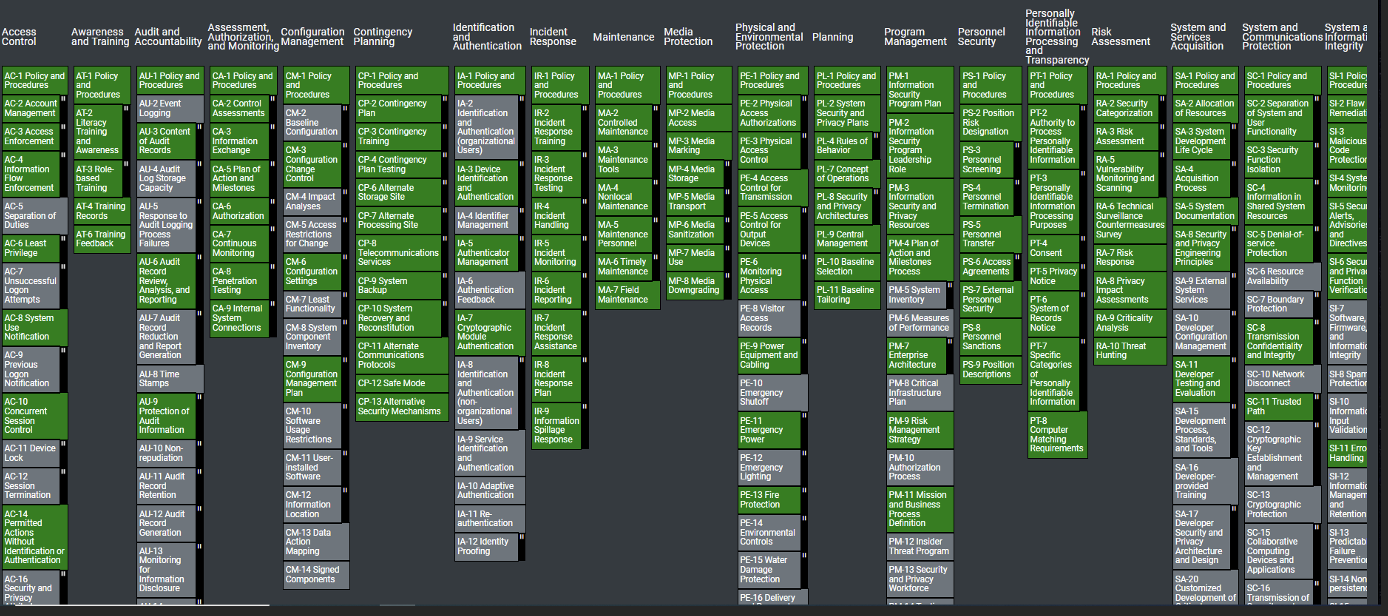
To see how the selected controls provide coverage against TTP(s) simply scroll down:
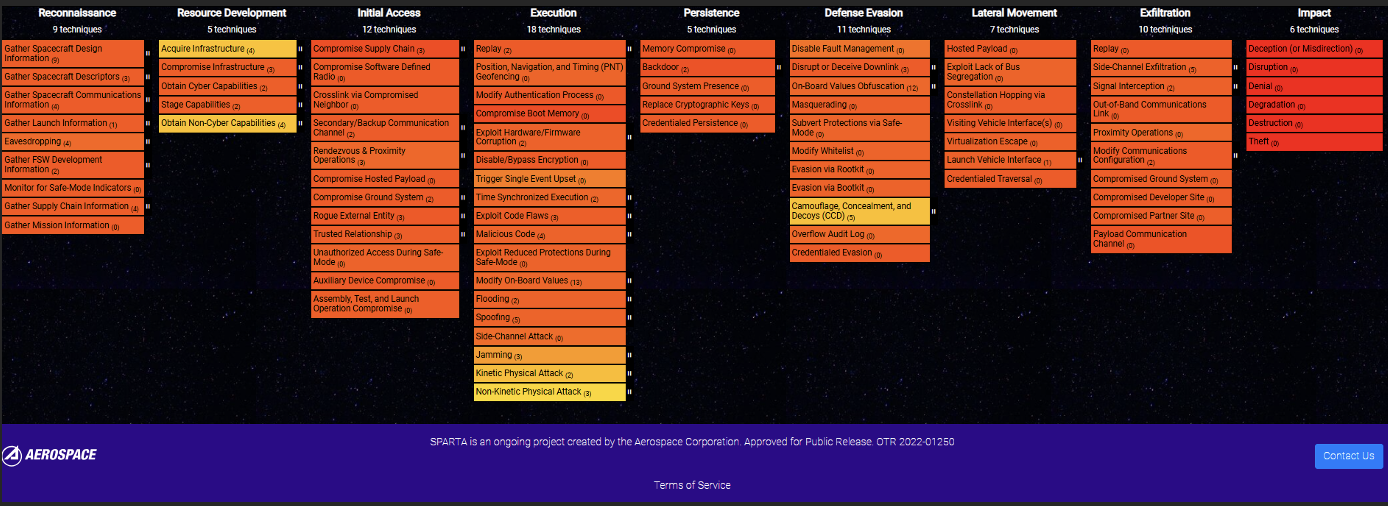
In this case, the TTP coverage based off of the NIST controls is lacking. Remember to reference the below spectrum to evaluate TTP coverage:

Lastly, if you would like to export data, the SPARTA Control Mapper allows you to do so with JSON, as a PNG, or in an Excel format:
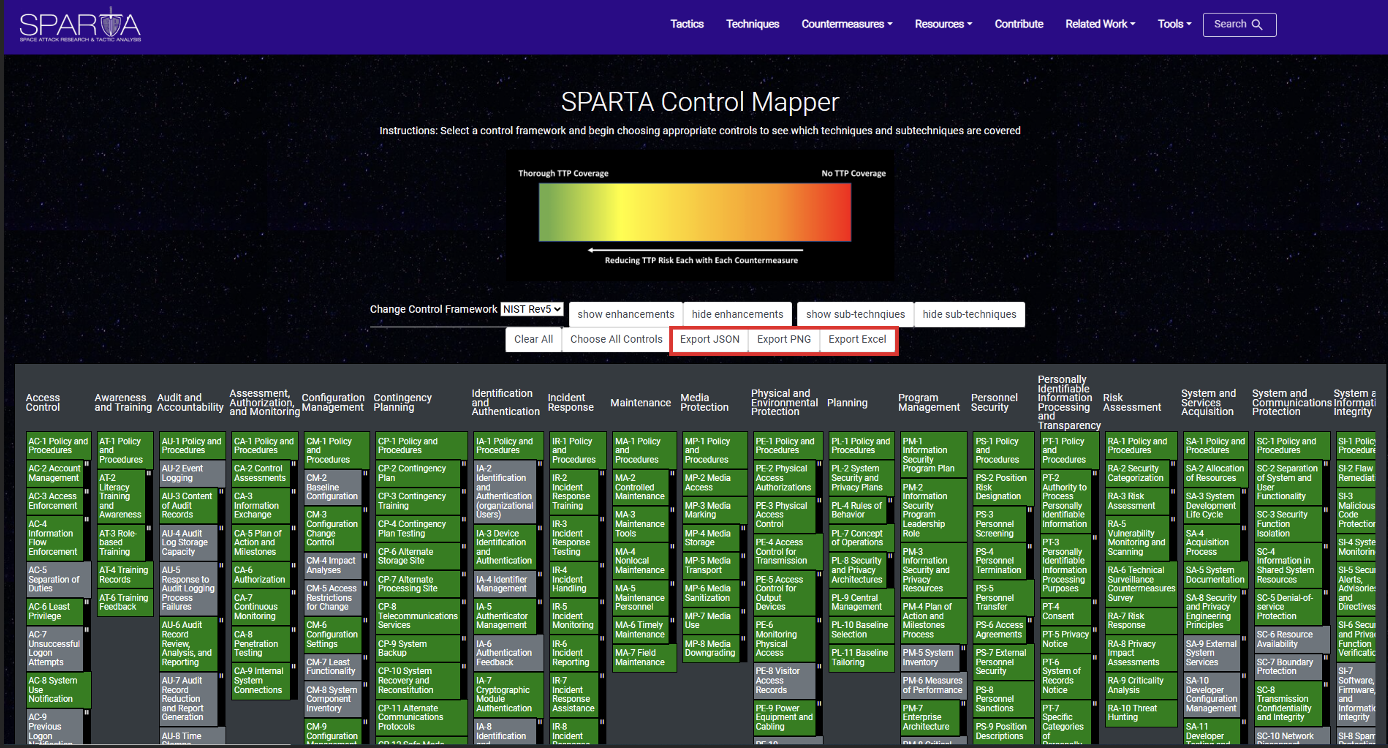
Spacecraft Mapper
The Spacecraft Mapper enables the user to select different subsystems of a Spacecraft and identify possible SPARTA TTP(s) that could target it, or manifest within that area of the system, while also showing the countermeasures that could be implemented to combat the associated SPARTA TTP(s).
To use the Spacecraft Mapper start by creating a layer:
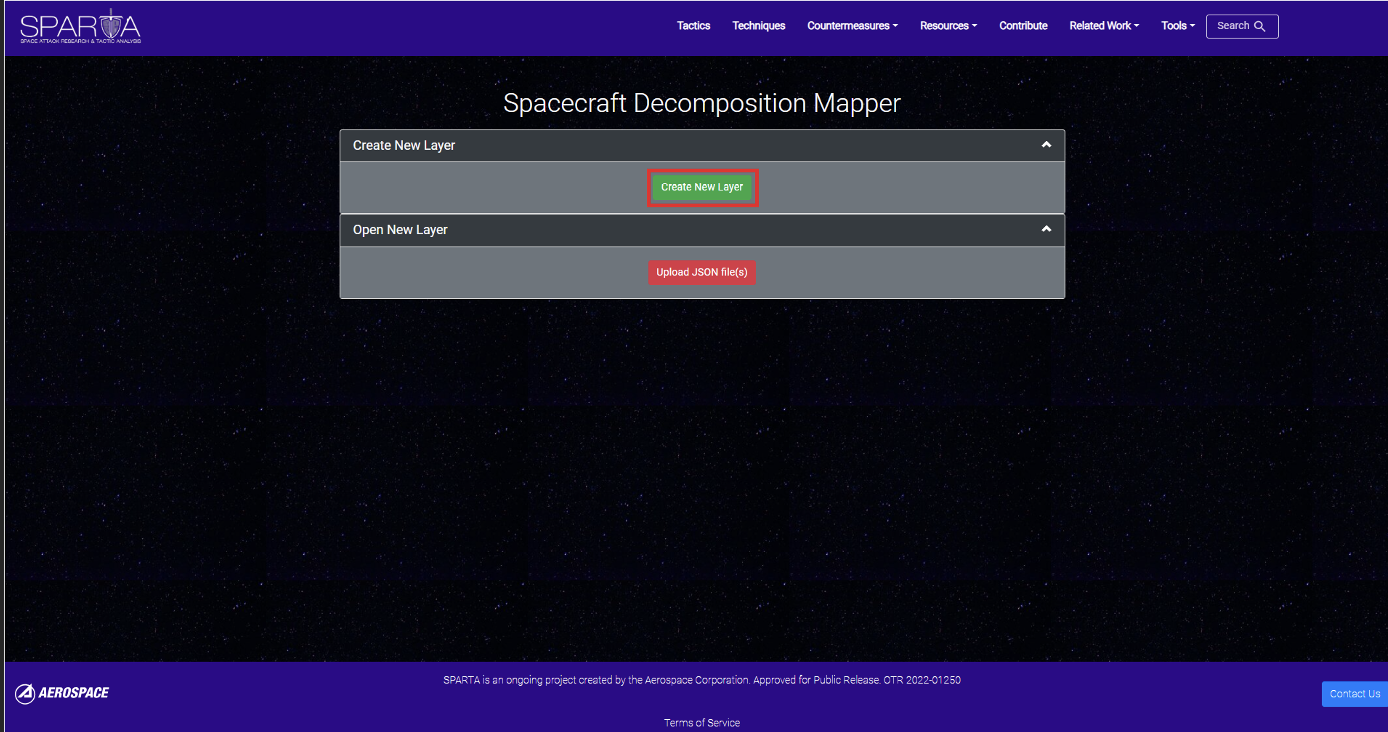
Next, select a subsystem(s) of a spacecraft to see the associated SPARTA TTP(s) that could lead to a compromise.
In the below example the “Flight Termination System (FTS)” was selected as the part. In blue you can see the part that was selected, in red you can see the possible SPARTA TTP(s):
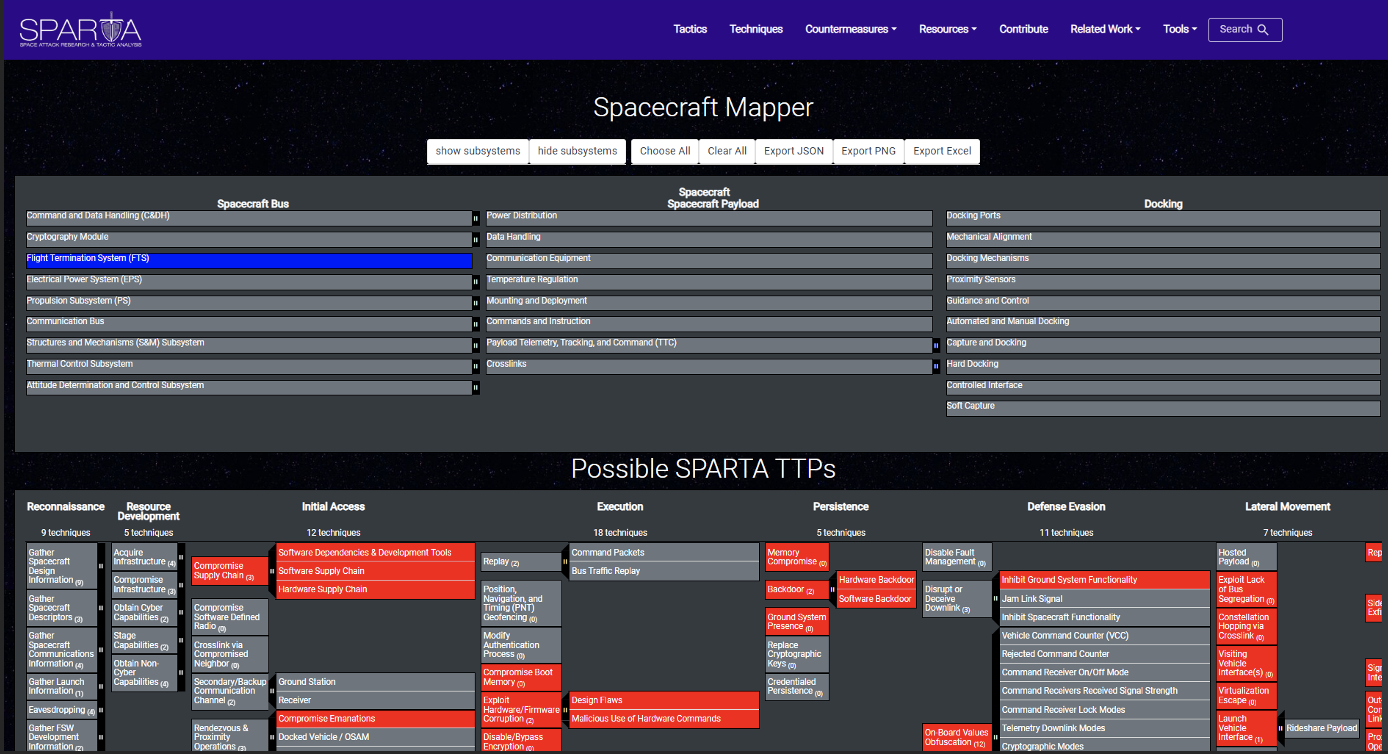
If you continue to scroll down past the SPARTA TTP(s) you will see the potential countermeasures that apply to the subsystem(s) in green:
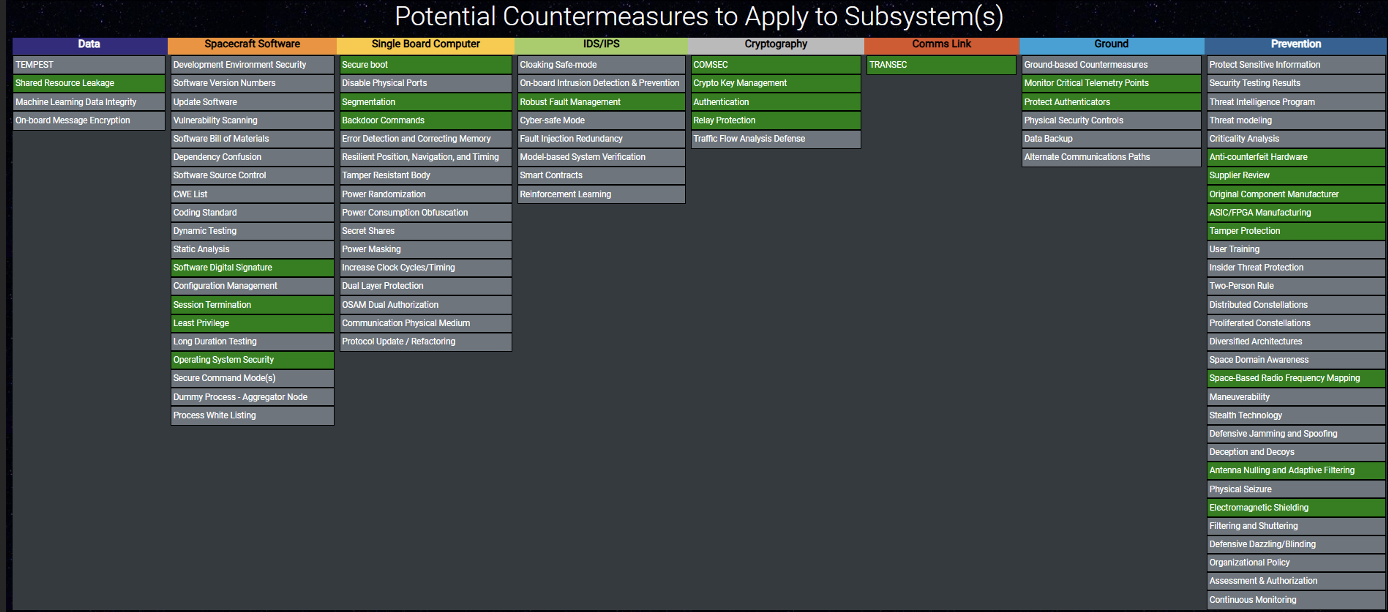
As is the case with the other mappers, you can also export your data in JSON, as a PNG, or in an Excel format:
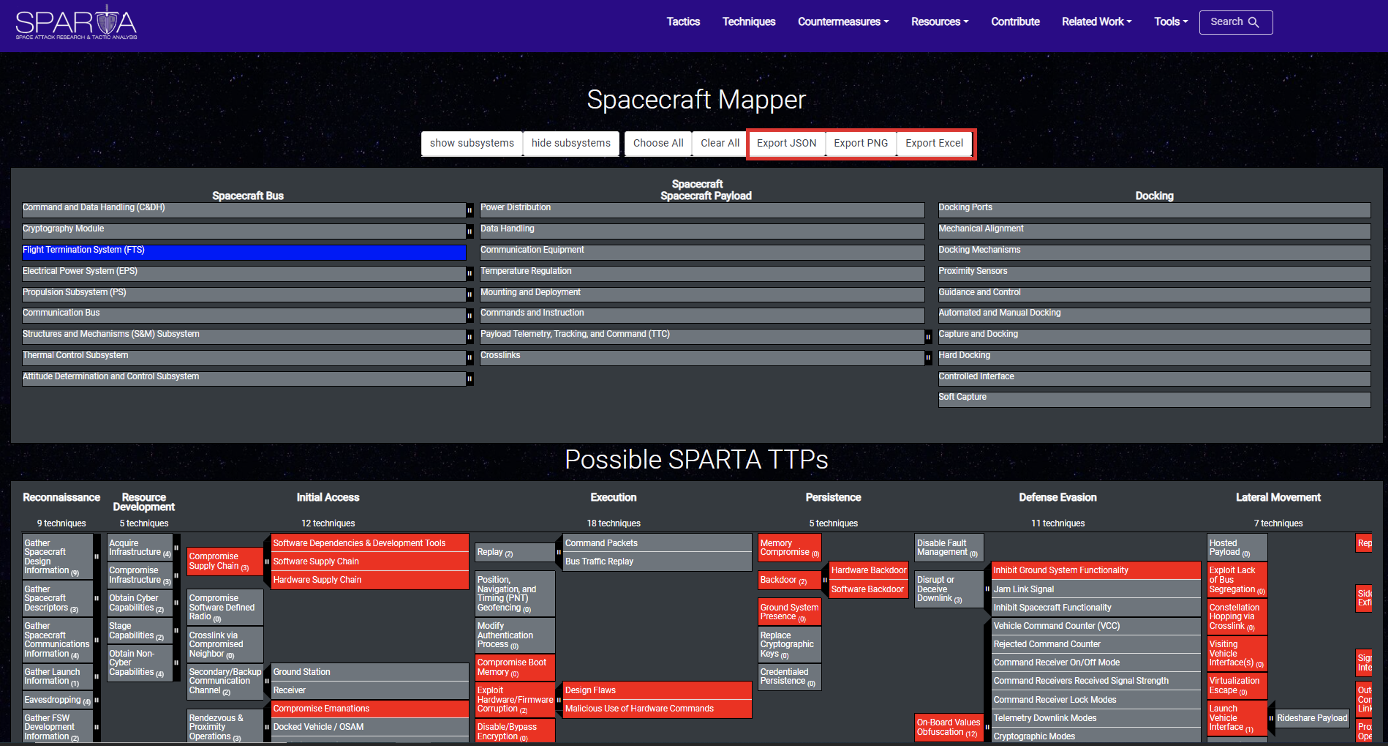
JSON Creator
The SPARTA JSON Creator is a tool for creating JSON objects to be used in the various SPARTA mapping tools; Navigator, CM Mapper, and Control Mapper. The user can easily copy/paste SPARTA TTPs, SPARTA Countermeasures, NIST 800-53 Rev 5 IDs, or ISO 27001 IDs into the top text area and convert the data into a specific SPARTA tool format. This JSON can then be downloaded and imported into the tool for editing and creating visuals. The expected format of the controls MUST match the format within the Countermeasure section of SPARTA (NIST, ISO). For example, NIST control must match control family-control number(enhancement number) with no leading zeros. This would look like AC-2(1) and not AC-02(1) or AC-02(01).
For instance, if you wanted to take TTPs and convert them to JSON for use by the navigator, you would simply get a list of the TTPs, delimit them using comma, and paste them into the upper-most text box and use the “Convert to JSON” button like so:

From here you can download the JSON output to a file and upload it into Navigator tool:

Upon uploading the JSON file to the Navigator tool you will see the three SPARTA TTPs are selected:
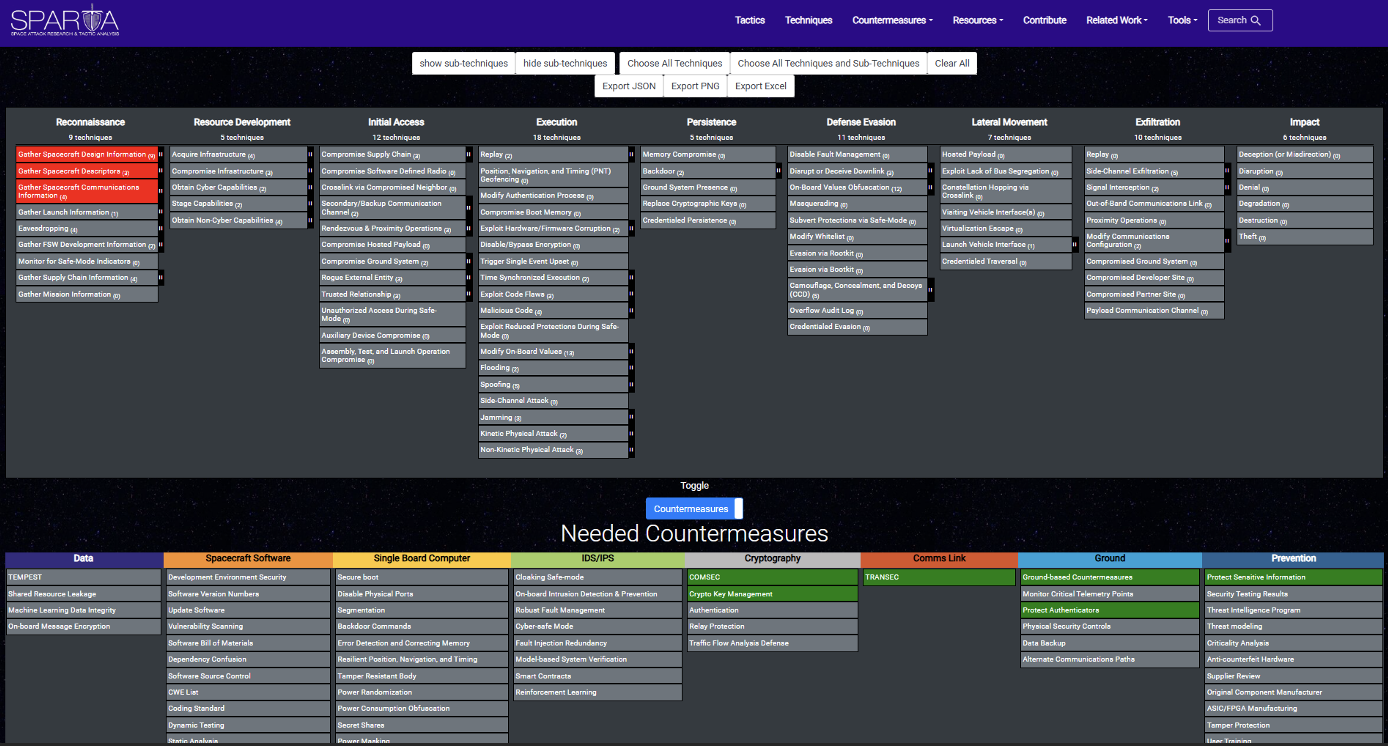
Space System Cybersecurity Questionnaire
The Space System Cybersecurity Questionnaire is designed to provide insight into an organization’s cybersecurity capabilities across the entire space system encompassing the space, ground, and user segments. The open-ended, free-form questions aim to elicit detailed responses that explain cybersecurity processes, capabilities, and implementations in use by an organization. Because responses are narrative and not bound to a rigid scoring model, it is recommended that experienced cybersecurity subject matter experts (SMEs) conduct the evaluation to ensure comprehensive interpretation and analysis. Evaluators should also be aware that assessment outcomes may be subjective and influenced by the assessor's experience and expertise.
The questions were developed using industry best practices and threat-informed guidance from The Aerospace Corporation’s TOR-2021-01333 REV A and the SPARTA framework. They focus on essential threats and vulnerabilities outlined in the TOR document and prioritize high-risk techniques identified through SPARTA’s Notional Risk Scores. The goal is to drive a more defensible, threat-aware cybersecurity posture for space missions.
On the questionnaire page you will find a three-column long table. The first column holds the open-ended question, the second column has further details that could be used to guide the questions and get more information, while the third column holds links to informative resources:
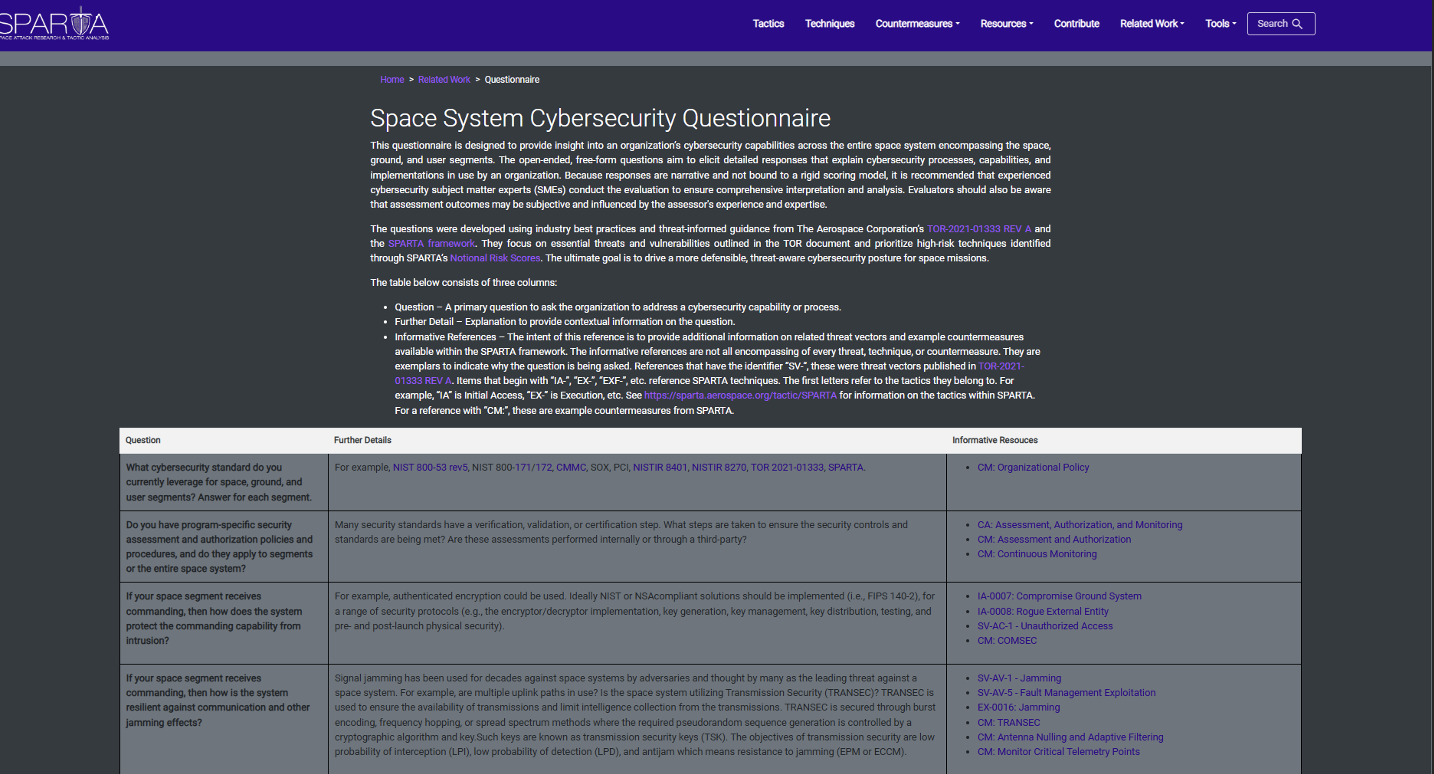
Use Cases Example: Space System Developers
In utilizing SPARTA, engineers now have a resource that contains TTPs, threats, and countermeasures to enable the engineering of protections early in the lifecycle, establishing countermeasures to disrupt the attack chains. The following process illustrates how engineers could implement SPARTA into their development cycle:
- Step 1: Enumerate end-to-end system during all phases of mission development and operations
- A combination of Enterprise IT and ICS/OT cyber controls/protections would be applied to the systems enumerated on ground using any of the following resources
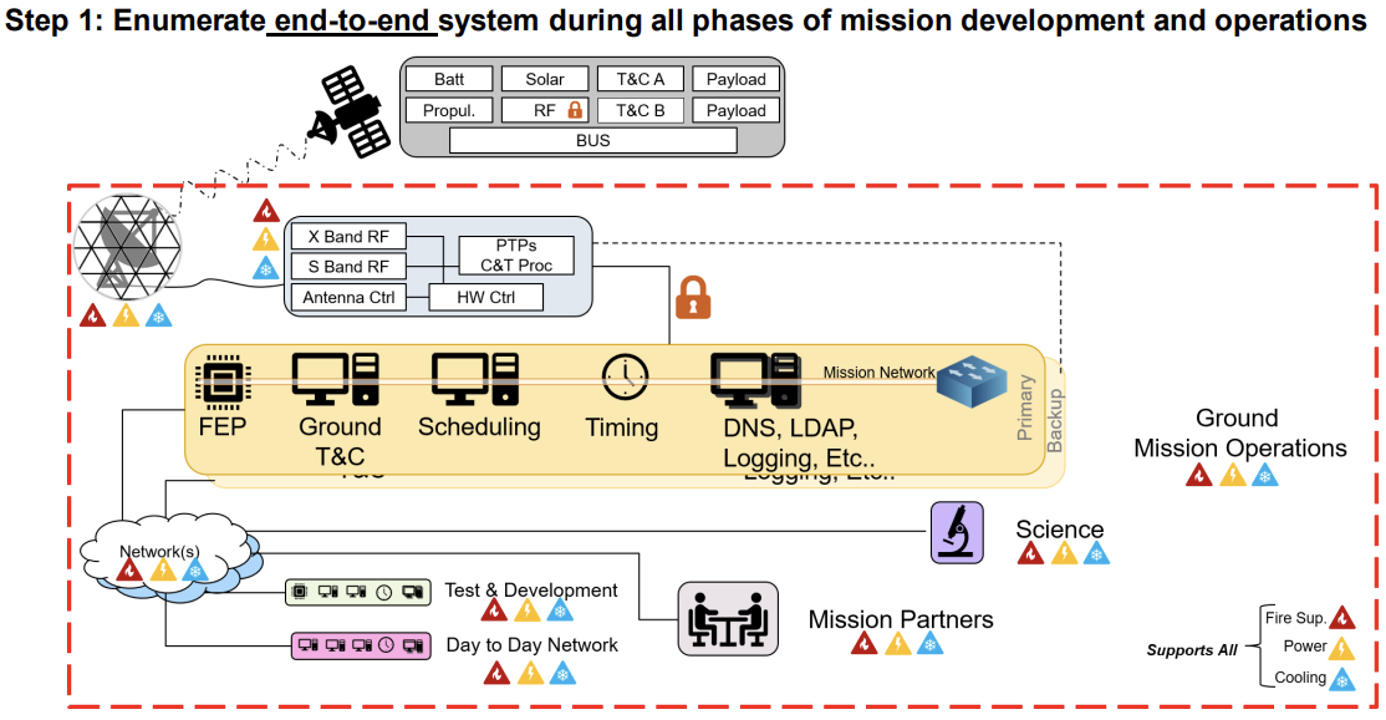
- Step 2: Review each threat, technique and sub-technique and make applicability determination based on your specific mission/system context FOR EACH element identified in Step 1

- Example could be the Compromise Boot Memory technique

-
Step 3: Evaluate current design choices to identify potential gaps that would leave element(s) vulnerable to applicable threats/techniques (as determined in Step 2) – Consider implementing SPARTA Countermeasures (CM) mapped to applicable techniques where gaps exist in current design
- Implementing multiple countermeasures aligns with defense-in-depth principles
- After you select 1 to N number of techniques you would like to mitigate in your system design. Then you select the countermeasures applicable to your design which can be derived into requirement language. The best way to gain access to requirement language is via the Countermeasures that are linked to the technique.
- An alternative method to get access to requirements is via techniques mapped to Aerospace Threat IDs can assist with generating requirement language.
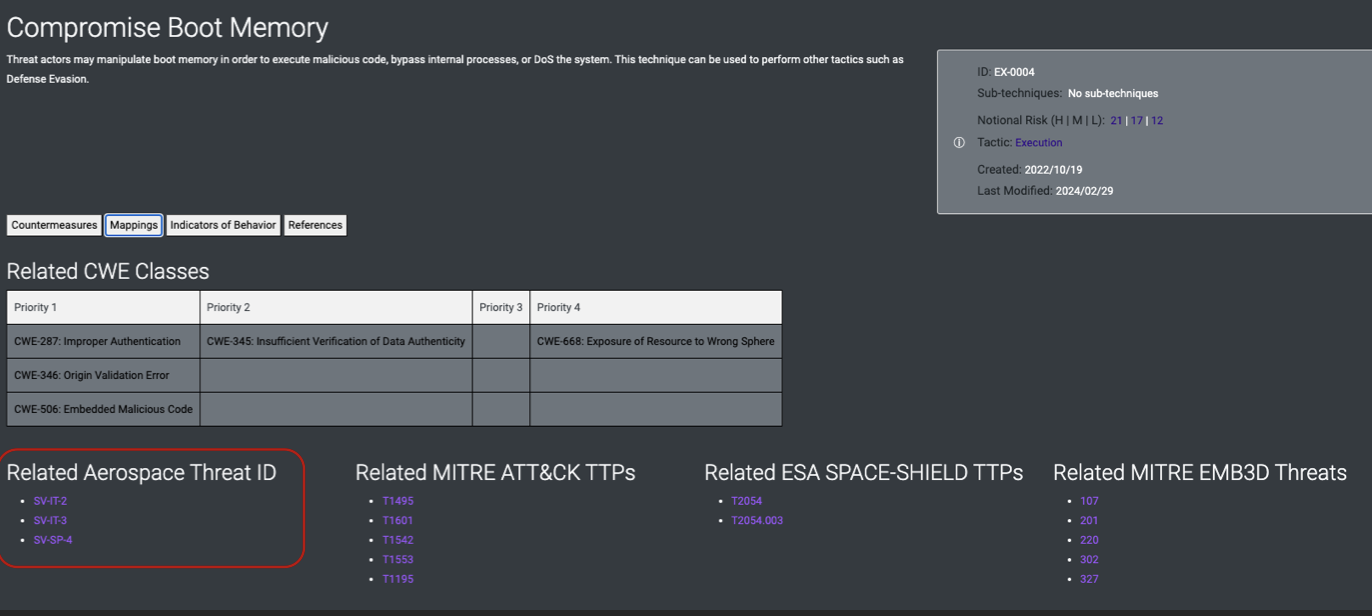
-
Additional relevant information that can help inform design are the mapped CWEs that appear on the mappings tab for each technique. These are weakness classes from the CWE database that the technique would target during exploitation. Therefore, the system engineer should design out those weaknesses to reduce the likelihood of exploitation by an adversary.
- One step further are the NIST 800-160 security principles that help mitigate the CWEs. These can be viewed for each individual subsystem or component of the spacecraft within the functional decomposition page.
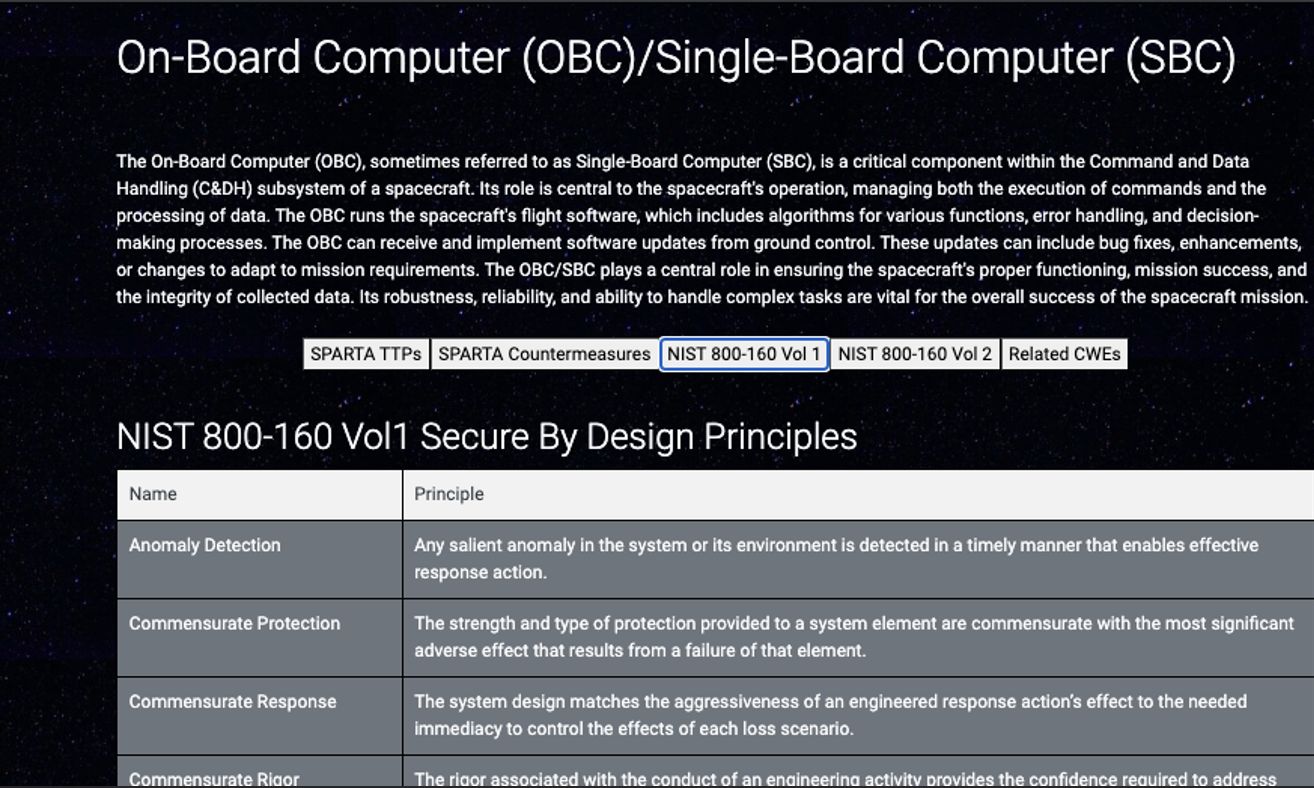
- One step further are the NIST 800-160 security principles that help mitigate the CWEs. These can be viewed for each individual subsystem or component of the spacecraft within the functional decomposition page.
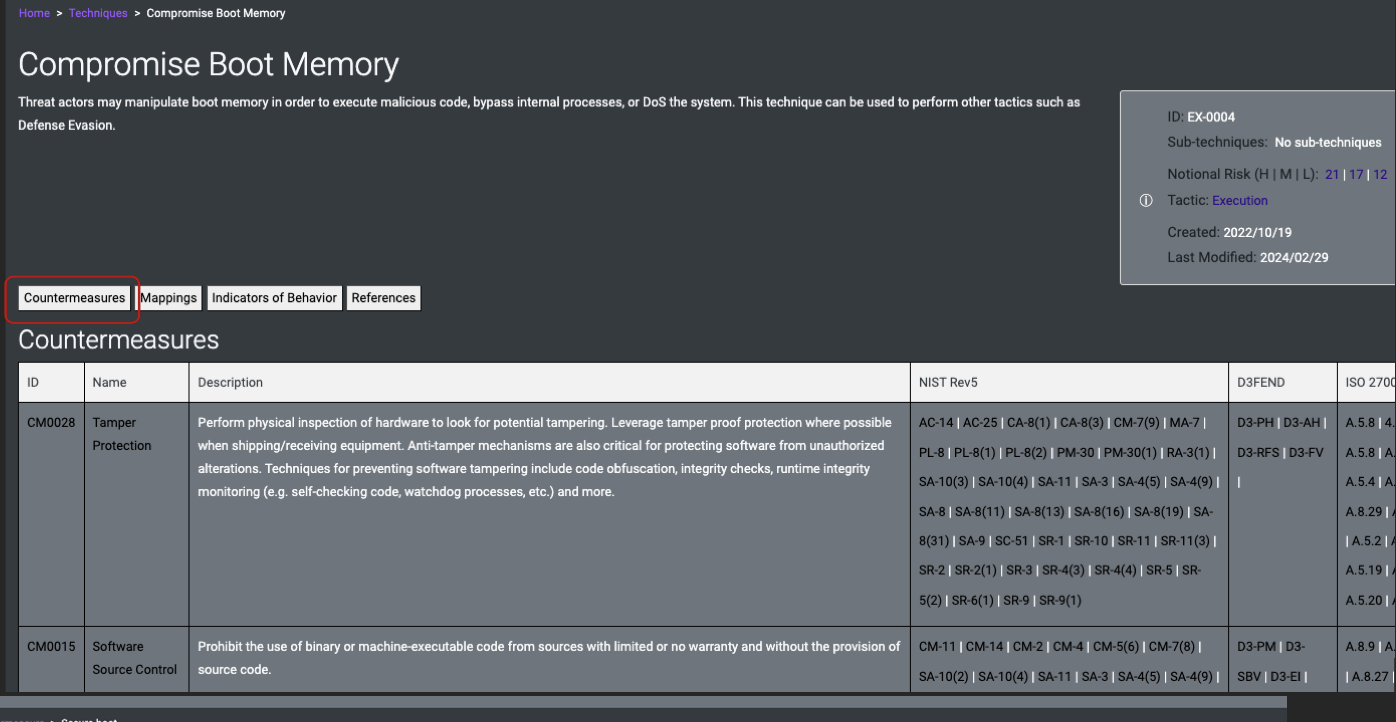
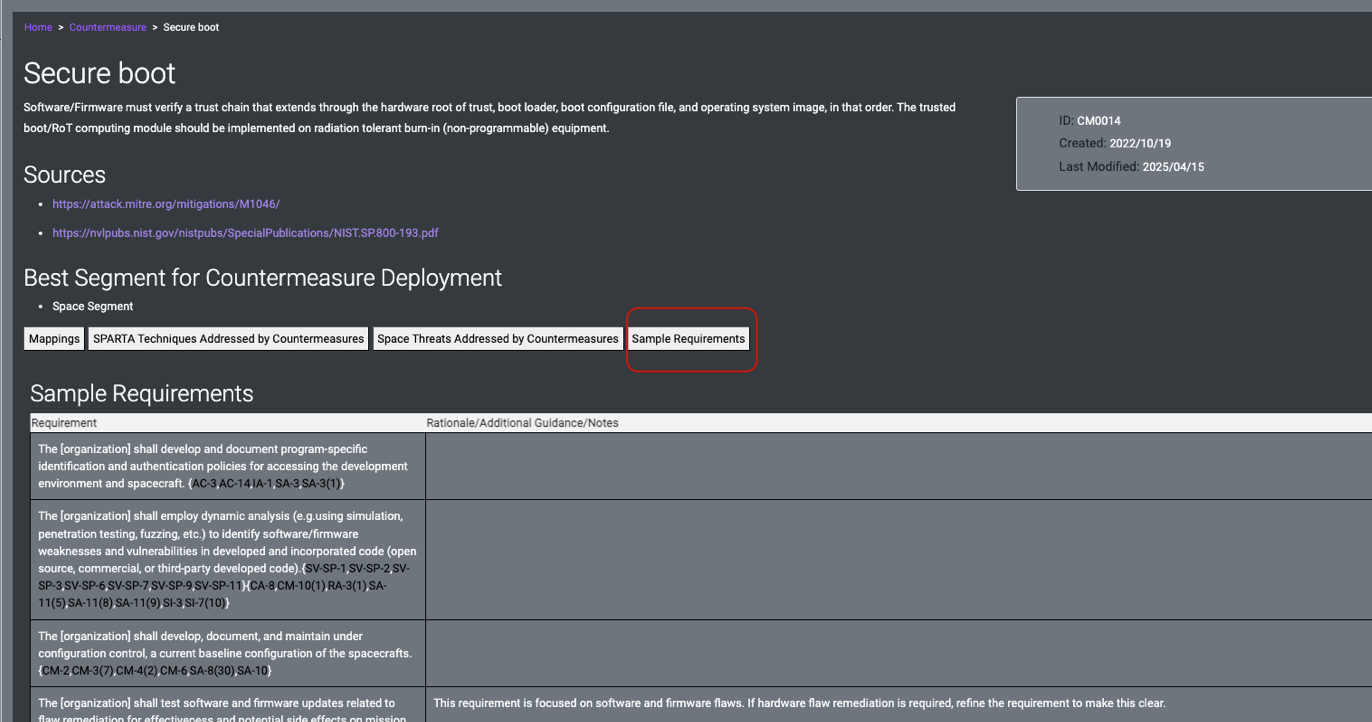
Use Cases Example: Threat Intel Reporting & Sharing
A key driver behind SPARTA is the absence of robust, widely shared cyber incident data for spacecraft. While enterprise networks have decades of documented intrusions and frameworks like MITRE ATT&CK to structure cyber threat intelligence (CTI), the space domain is only now emerging as a focus for systematic threat modeling. Spacecraft often depend on bespoke designs, proprietary protocols, and isolated architectures, which makes adversary behaviors harder to document and share.
SPARTA provides the space community with a common language for describing adversary tactics and techniques, enabling CTI to be tracked, reported, and compared across missions and organizations. This improves situational awareness, helps programs identify where they may be vulnerable, and supports consistent reporting of threat activity. As more insights are gained through red-teaming, exercises, and real-world incidents, SPARTA evolves to expand its coverage and refine its fidelity.
The benefit of this approach is that space missions can leverage CTI not only to understand how adversaries operate but also to build proactive defenses. SPARTA makes it possible to connect threat behaviors to countermeasures, map them to standards and controls, and share intelligence across the community in a structured way. This ensures that spacecraft protection is informed by realistic, mission-relevant scenarios and that defenses are continuously updated as the threat landscape evolves.
An example of how this has been performed for IT systems can be seen below where ATT&CK IDs are reported in intel reports and/or CTI.
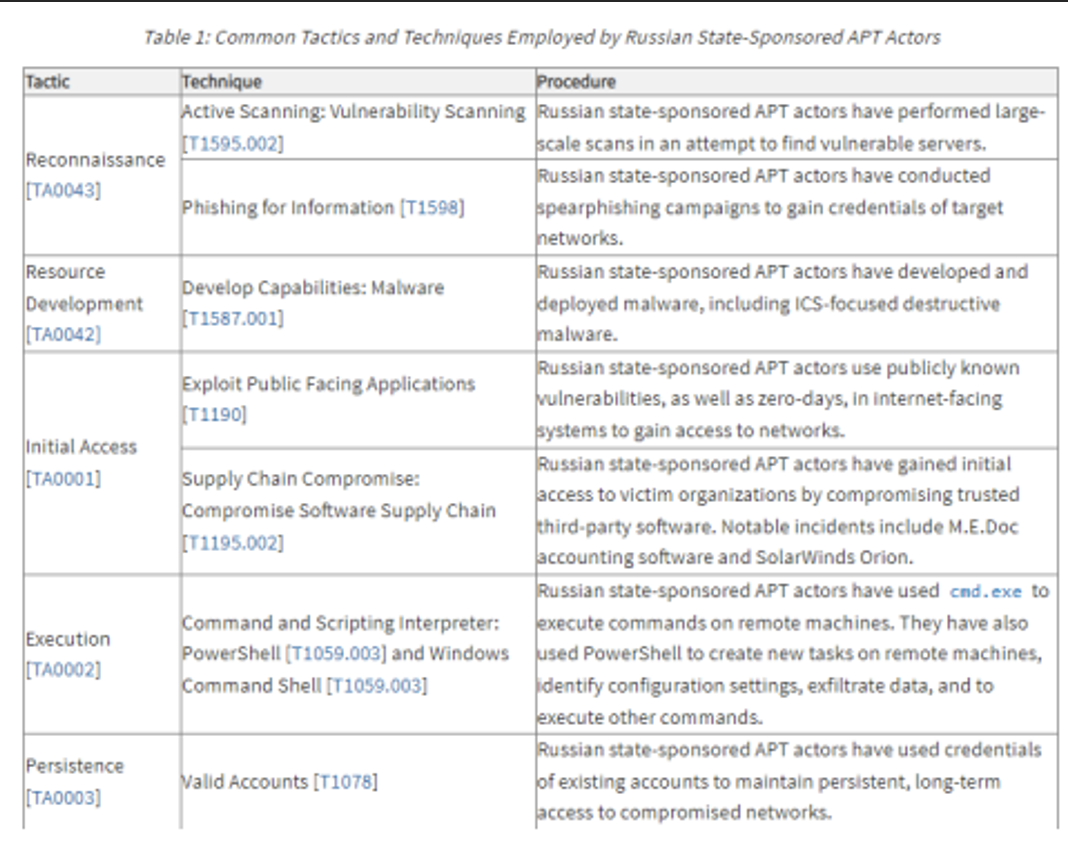
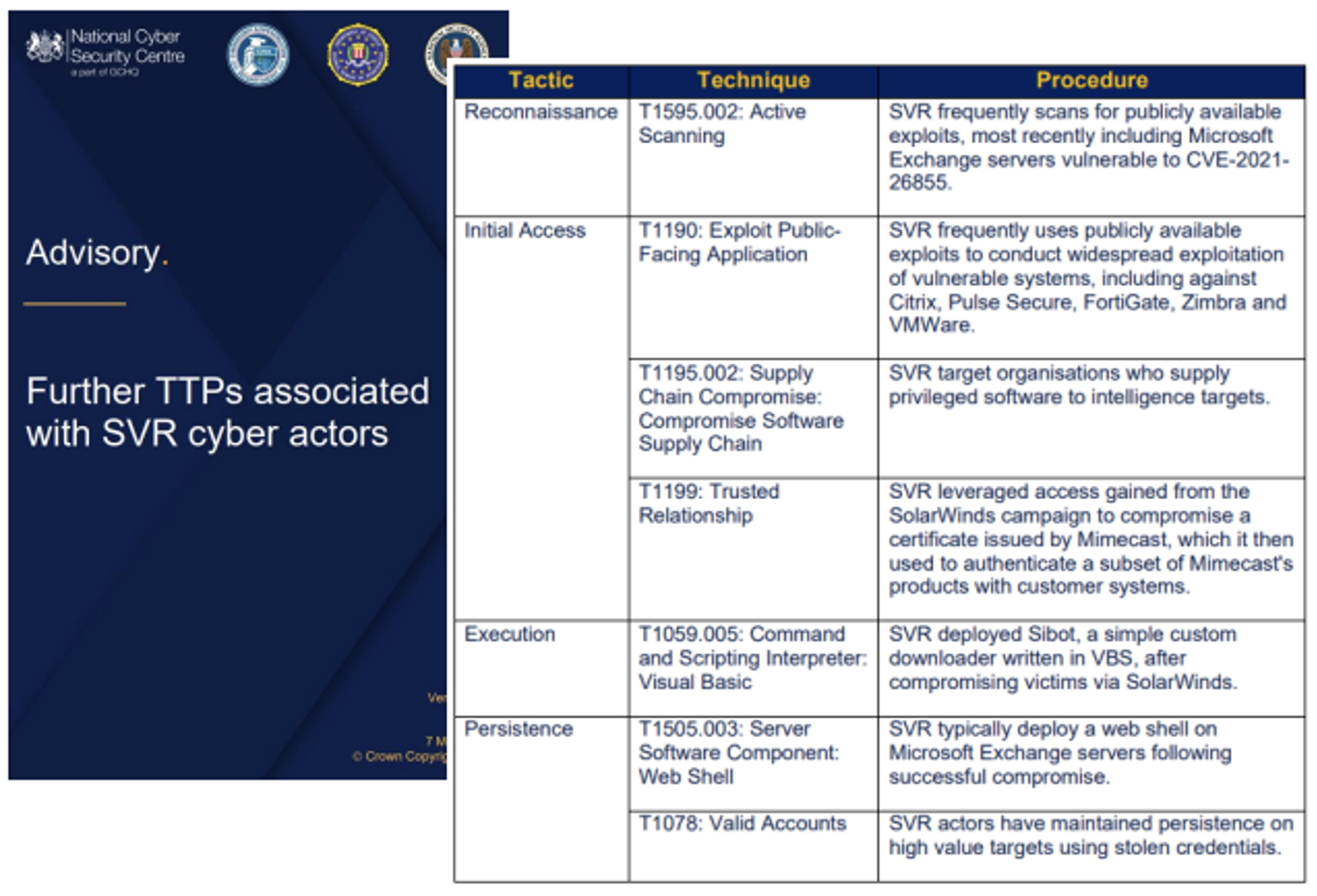
Groups like the SPACE ISAC have already started reporting incidents and threat activity using SPARTA TTPs to tag the reports, which provides a much needed common language for information sharing.

Use Cases Example: Table-Tops
SPARTA can be used to build realistic, threat-informed scenarios for table-top exercises, red teaming, and simulations. By grounding exercises in documented adversary TTPs, organizations can walk through cyberattack scenarios that mirror real-world threats to space systems, such as jamming, command injection, or compromise of ground stations. This ensures teams practice detecting, responding to, and recovering from authentic adversarial behaviors rather than generic attacks. SPARTA also supports red teams in constructing sophisticated attack chains that span ground, link, and space segments, and provides defenders with a framework to evaluate detection gaps and incident response effectiveness. After each exercise, teams can map observed gaps back to SPARTA techniques, enabling iterative improvement and helping organizations steadily mature their space system security posture.
Using SPARTA for Table-Top Exercises – Quick Steps
Define the Scenario
- Choose a mission-relevant context (e.g., spacecraft operations disruption, ground station compromise).
- Identify the mission objectives or assets you want to stress-test.
Select Relevant Techniques
- Use SPARTA to identify realistic adversary TTPs aligned to your scenario (e.g., IA-0006 Compromise Hosted Payload, EX-0012 Modify On-Board Values, etc.).
- Consider chaining techniques across ground, link, and space to reflect how real adversaries operate.
Build the Attack Chain
- Map out the sequence of steps an adversary would take, using SPARTA techniques as building blocks. Tools like Attack Flow can support this analysis.
- Include possible pivot points (e.g., lateral movement from host spacecraft to payload).

Walk Through the Exercise
- Have participants discuss how they would detect, respond to, and recover from each step of the attack chain.
- Reference SPARTA countermeasures to highlight potential defenses.
Capture Indicators & Gaps
- Note what indicators (telemetry, logs, network events) should have been detected.
- Identify gaps in detection, response procedures, or communications.
Refine and Iterate
- Map gaps back to SPARTA techniques to track what wasn’t detected or mitigated.
- Use lessons learned to design follow-up exercises that progressively increase realism.
Traceability Mappings within SPARTA
The SPARTA Team performs various traceability mappings across many different data elements. We pursue these mappings to position SPARTA as a comprehensive reference point, a Rosetta Stone for spacecraft cybersecurity, that unifies diverse sources of knowledge into a single, accessible framework. There is a wealth of excellent work across the cybersecurity community, and our goal is not to reinvent it, but to integrate and connect it where it makes sense. By creating these mappings, SPARTA ensures that engineers, operators, and analysts can cross-reference frameworks, standards, and datasets in one place, enabling more efficient design, assessment, and defensive operations.
SPARTA Technique Mappings
-
MITRE ATT&CK → SPARTA Techniques
- Provides continuity with the broader cyber community by showing how well-understood enterprise and ICS tactics/techniques overlap or diverge when applied to spacecraft. This helps space engineers leverage existing MITRE ATT&CK® knowledge while accounting for space-unique threats.
-
ESA SPACE-SHIELD → SPARTA Techniques
- Connects European standards and taxonomies to SPARTA, fostering international consistency. This mapping allows European missions already applying SPACE-SHIELD to quickly see how their protections align with SPARTA techniques.
-
CWE Classes → SPARTA Techniques
- Shows which classes of software and hardware weaknesses adversaries target when executing a SPARTA technique. This mapping grounds SPARTA in the Secure-by-Design philosophy and helps developers understand the underlying flaws to engineer out of spacecraft designs.
-
NIST SP 800-160 Vol. 1 & Vol. 2 → SPARTA Techniques
- Associates each weakness class with NIST’s system security (v1) and resilience principles (v2). This mapping turns abstract principles into concrete mitigations by linking them to SPARTA techniques and their associated CWEs.
-
TOR-2021-01333 SV Threats → SPARTA Techniques
- Connects Aerospace’s early foundational threat assessment work to SPARTA techniques, ensuring lessons learned from TOR-2021-01333 continue to inform modern spacecraft threat modeling.
-
MITRE EMB3D Threats → SPARTA Techniques
- Adds embedded system focused threat information from EMB3D to SPARTA. This gives spacecraft engineers deeper insight into embedded systems attack vectors that might not otherwise be fully represented in higher-level technique taxonomies.
-
SPARTA IOBs → SPARTA Techniques
- Links behavioral detections directly back to the adversary techniques they indicate. This mapping closes the loop from theory (TTPs) to practice (IOBs), enabling monitoring solutions and IDS rules to be traced back to specific threats.
SPARTA Countermeasure Mappings
-
NIST SP 800-53 Controls → SPARTA Countermeasures
- Shows how formal, government-recognized controls map to SPARTA countermeasures. This helps programs trace security requirements and compliance efforts directly into the spacecraft threat model.
-
ISO 27001 Controls → SPARTA Countermeasures
- Provides an international lens by aligning SPARTA countermeasures with ISO 27001, the globally recognized information security management standard. This ensures non-U.S. missions can leverage SPARTA within their regulatory and certification context. This is performed by using the existing SPARTA Countermeasure to NIST mapping and then translating using the NIST to ISO mapping performed by NIST.
-
MITRE D3FEND Techniques → SPARTA Countermeasures
- Connects SPARTA defenses with MITRE’s knowledge base of cyber defense techniques within D3FEND, enriching spacecraft countermeasures with best practices drawn from enterprise and ICS defensive operations.
-
MITRE D3FEND Artifacts → SPARTA Countermeasures
- Maps defensive telemetry and forensic artifacts captured in D3FEND to SPARTA countermeasures, highlighting what evidence should be collected to validate that a countermeasure is effective in practice.
-
MITRE EMB3D Mitigations → SPARTA Countermeasures
- Provides embedded-system-specific protections from EMB3D and ties them to SPARTA countermeasures, helping spacecraft teams defend at the embedded system level as well as at the operational level.
-
ESA Space Shield Mitigations → SPARTA Countermeasures
- Ensures that European mitigation guidance aligns from SPACE-SHIELD with SPARTA, strengthening interoperability and shared defense strategies across allied programs.
-
NASA Best Practices Guide → SPARTA Countermeasures
- Maps NASA’s spacecraft cybersecurity best practices directly to SPARTA countermeasures, providing a practical engineering link between agency guidance and SPARTA’s structured defensive taxonomy.
Accessing SPARTA Data
Structured Threat Information Expression (STIX™) is a language and serialization format used to exchange cyber threat intelligence (CTI). The SPARTA dataset is available in STIX 2.1.
STIX is a machine-readable format providing access to the SPARTA knowledge base. It is the most granular representation of the SPARTA data, and all other representations are derived from the STIX dataset.
The SPARTA STIX representation is most easily manipulated in Python using the stix2 library. However, because STIX is represented in JSON, other programming languages can easily interact with the raw content.
To download SPARTA you may either make a call to the API directly, or utilize the dropdown menu as described on the website:

For example, STIX/JSON output of SPARTA data looks like the following:
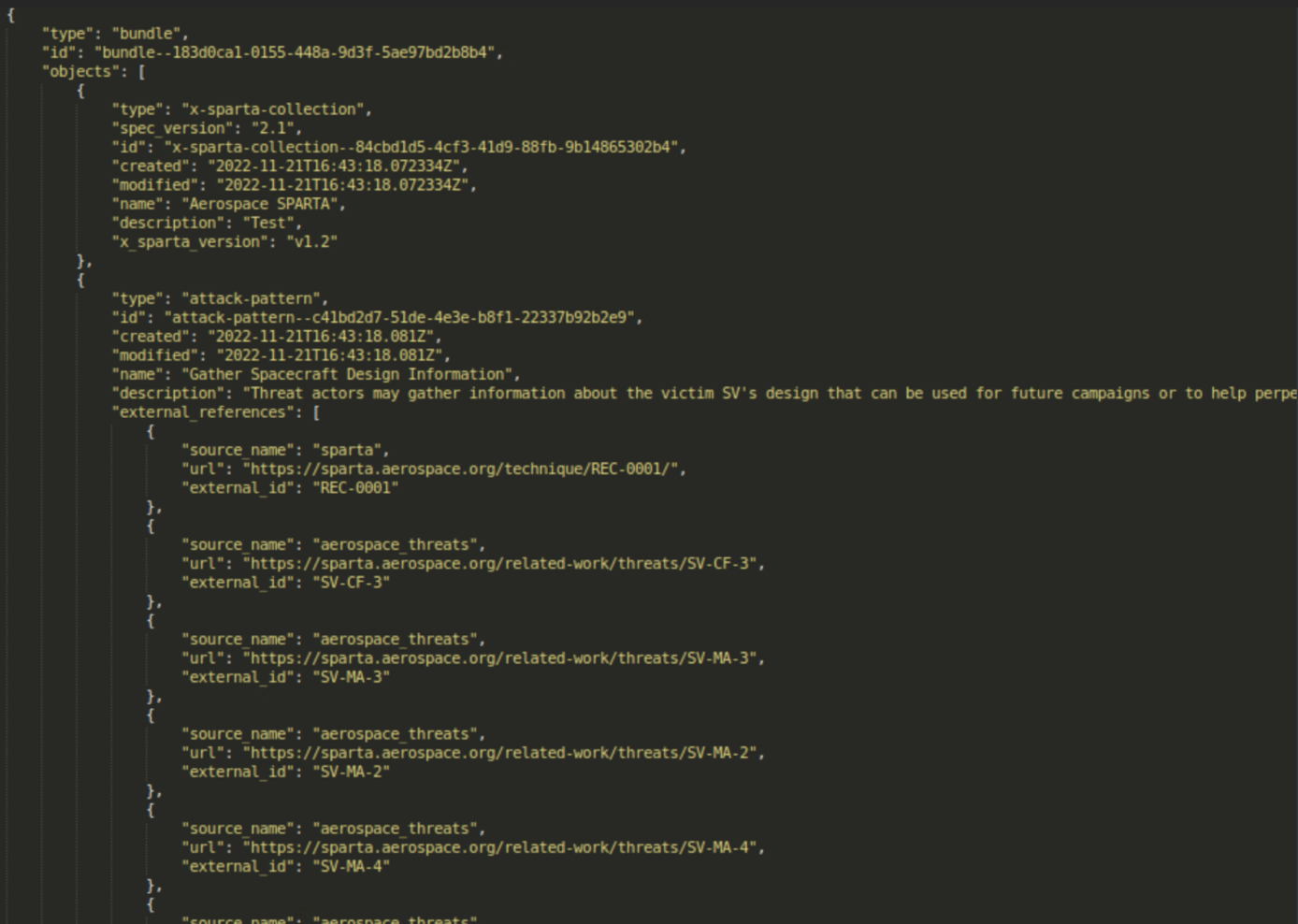
Alternatively, SPARTA can also be exported into Excel. These spreadsheets are dynamically built and provide a more human-accessible view into the knowledge base.
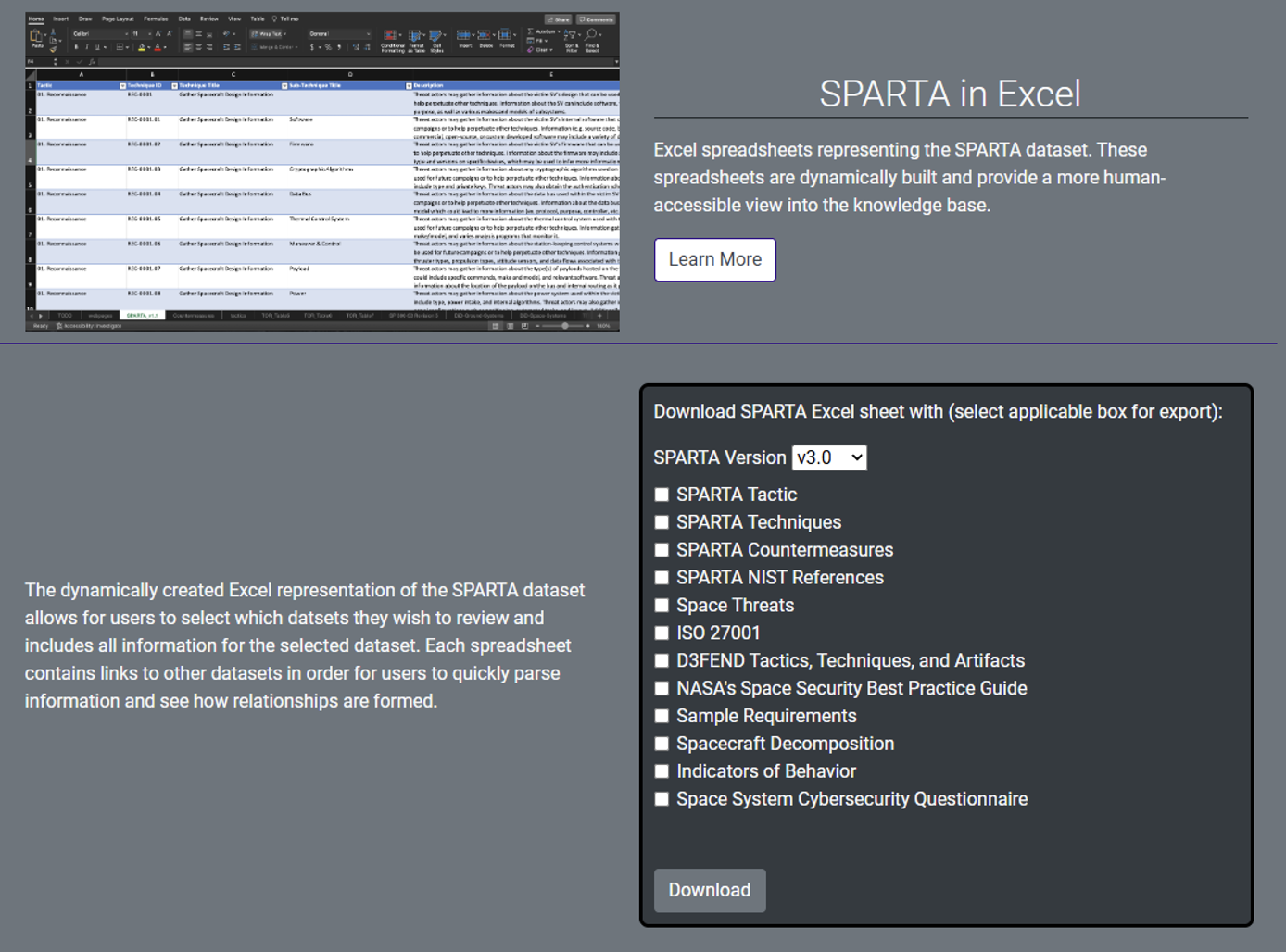
Extending and Contributing to SPARTA
SPARTA's usefulness relies on community engagement and collaboration. Below you will find several ways to contribute to SPARTA. If you don't see an option that suits your specific need, you can always email us directly at sparta@aero.org
All contributions and feedback to SPARTA are appreciated. If we find the contribution fills a gap, corrects an error, or improves existing content then we will work with you to make the necessary edits, listing you as a contributor if desired.
Before submitting any content, please consider whether SPARTA is the right place for it- does the concept/technique/idea primarily apply to the unique elements of a space system? Alternatively, TTPs geared towards traditional enterprise information technology, mobile devices, or industrial control systems (ICS) should be sent to MITRE for consideration within their existing matrices.
Techniques and Sub-Techniques
Data Sources
Countermeasures